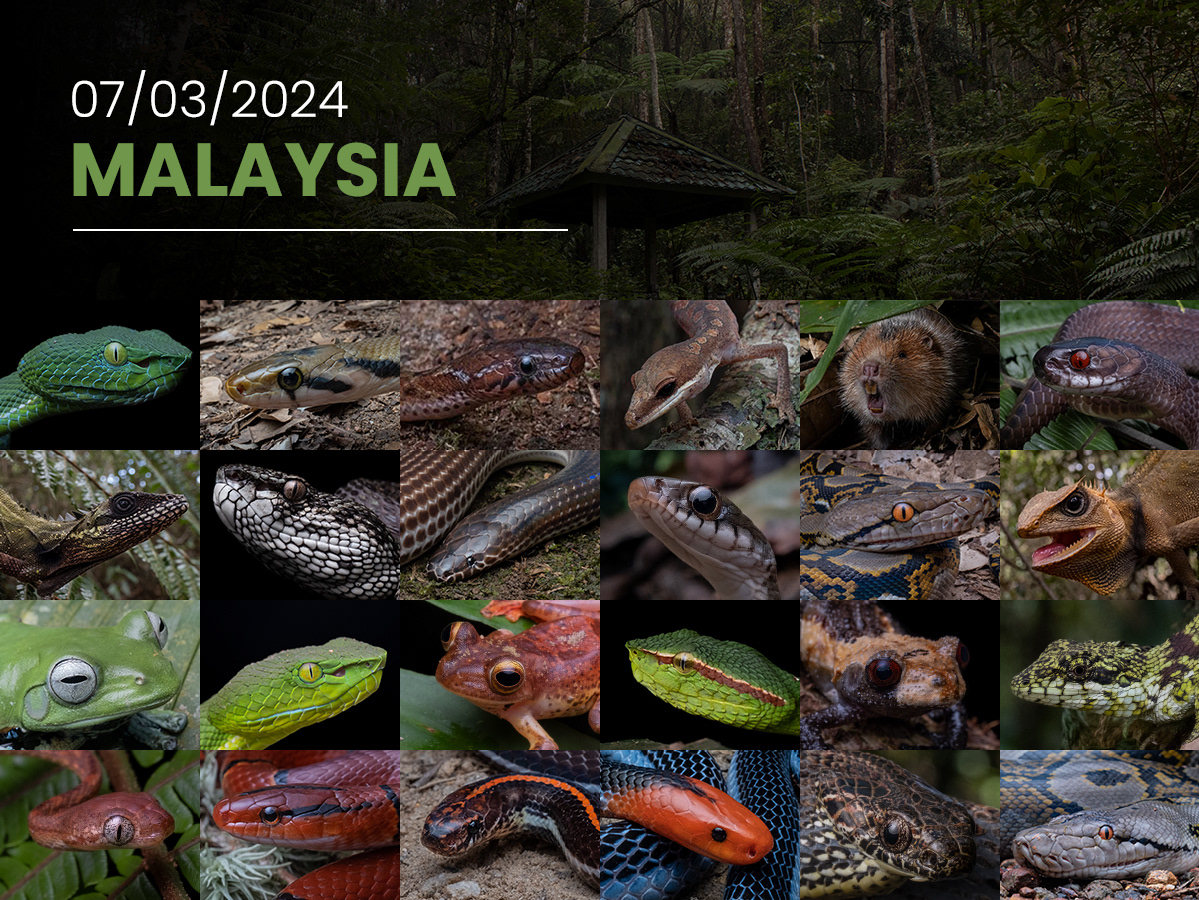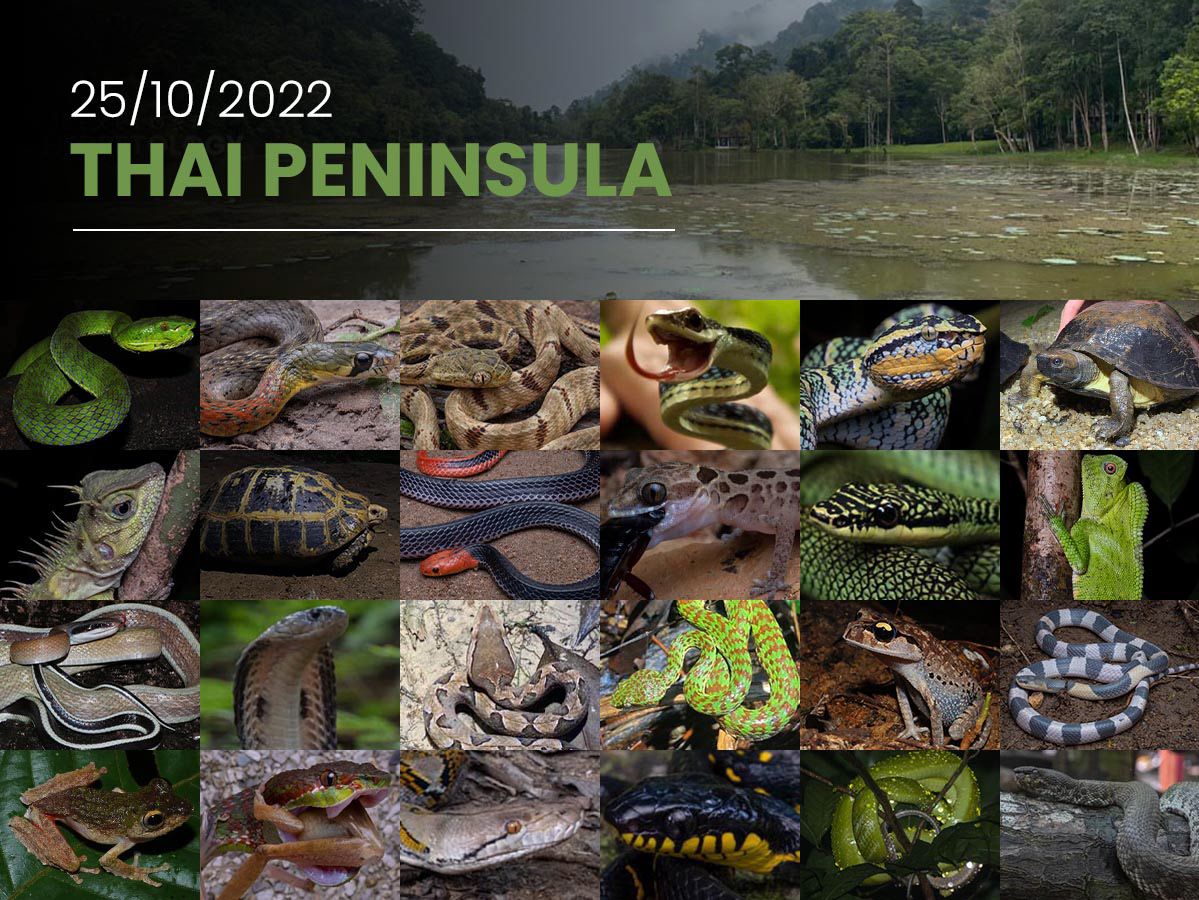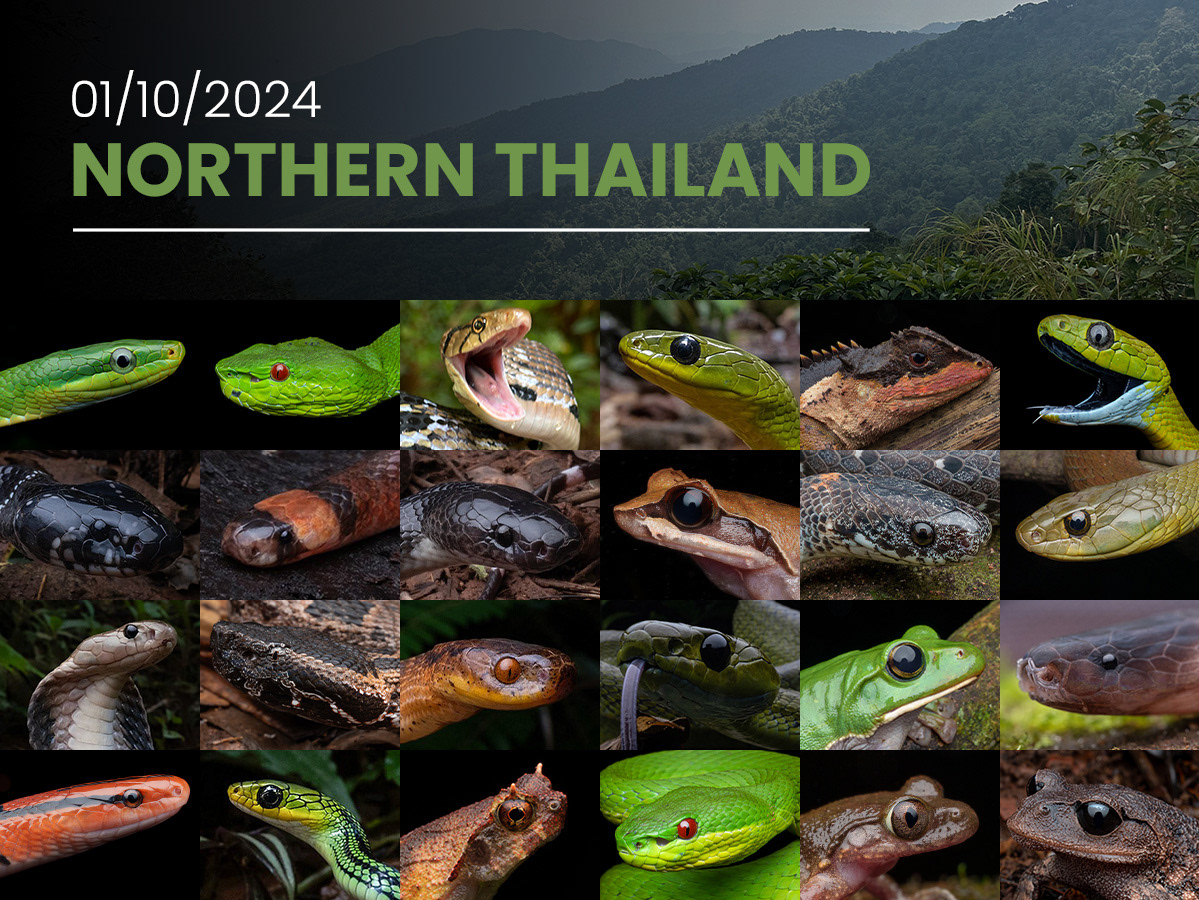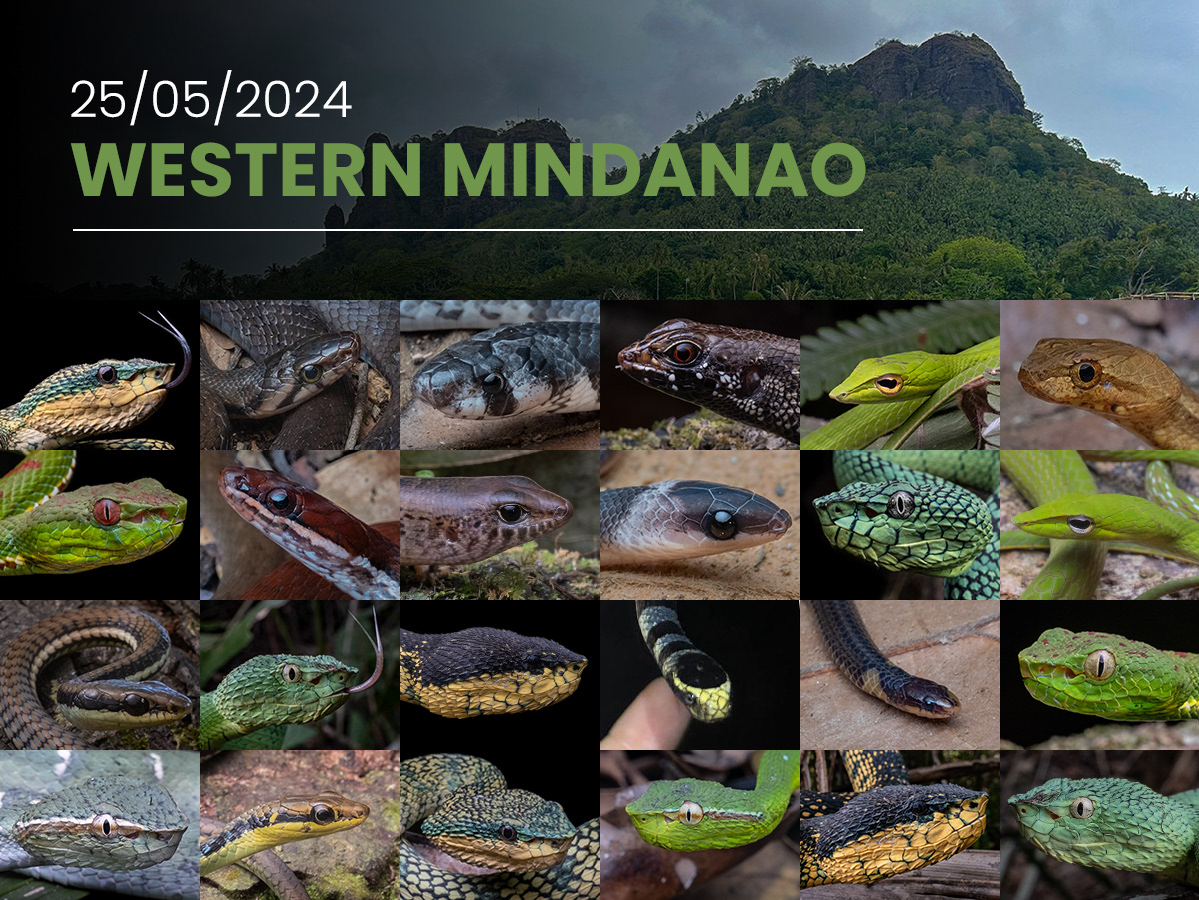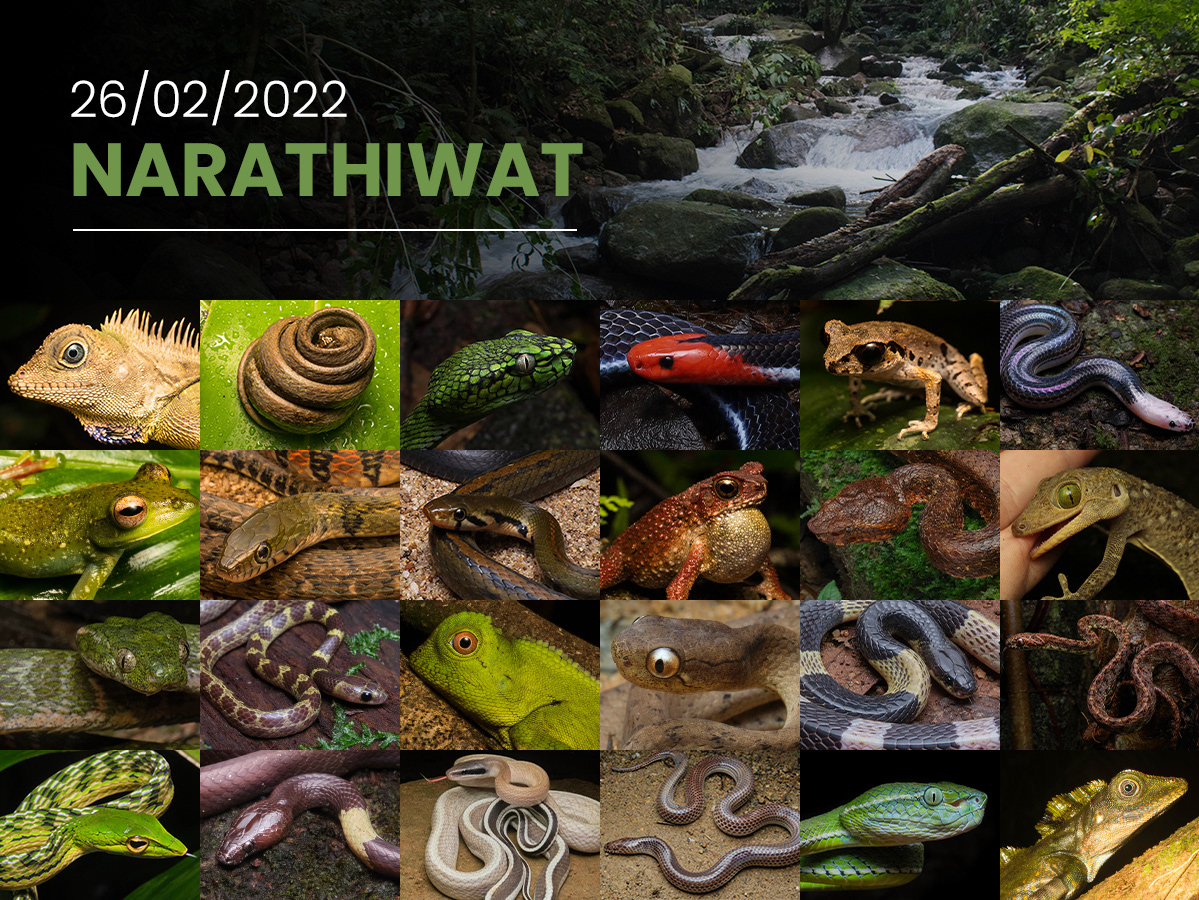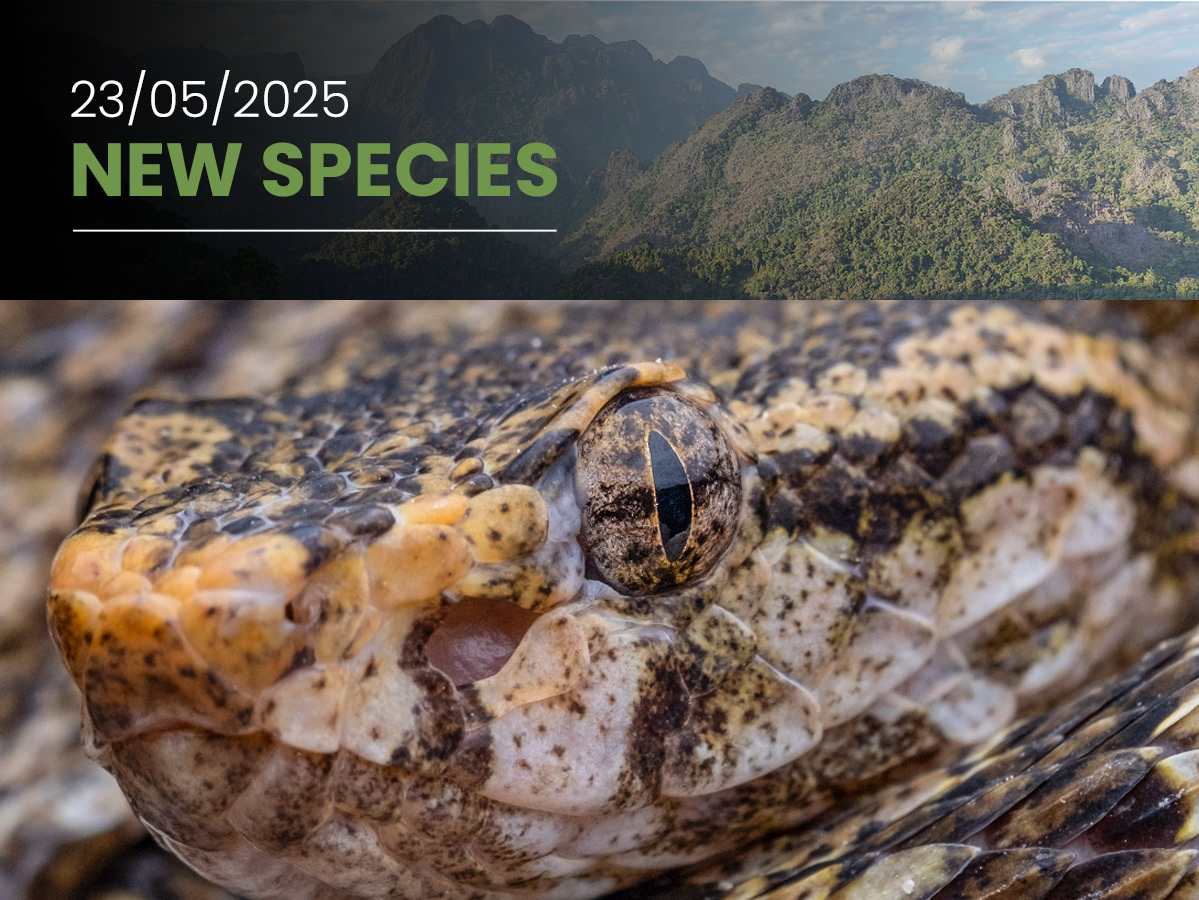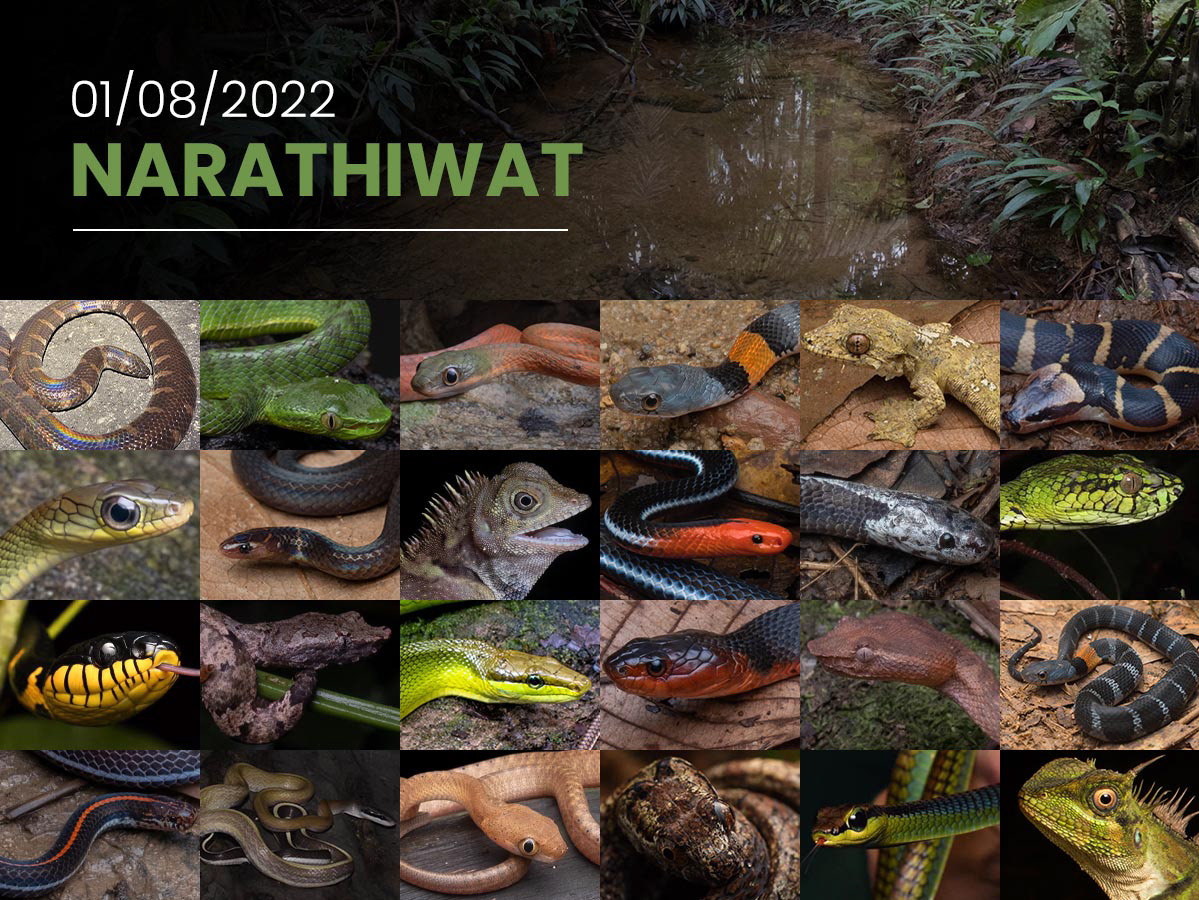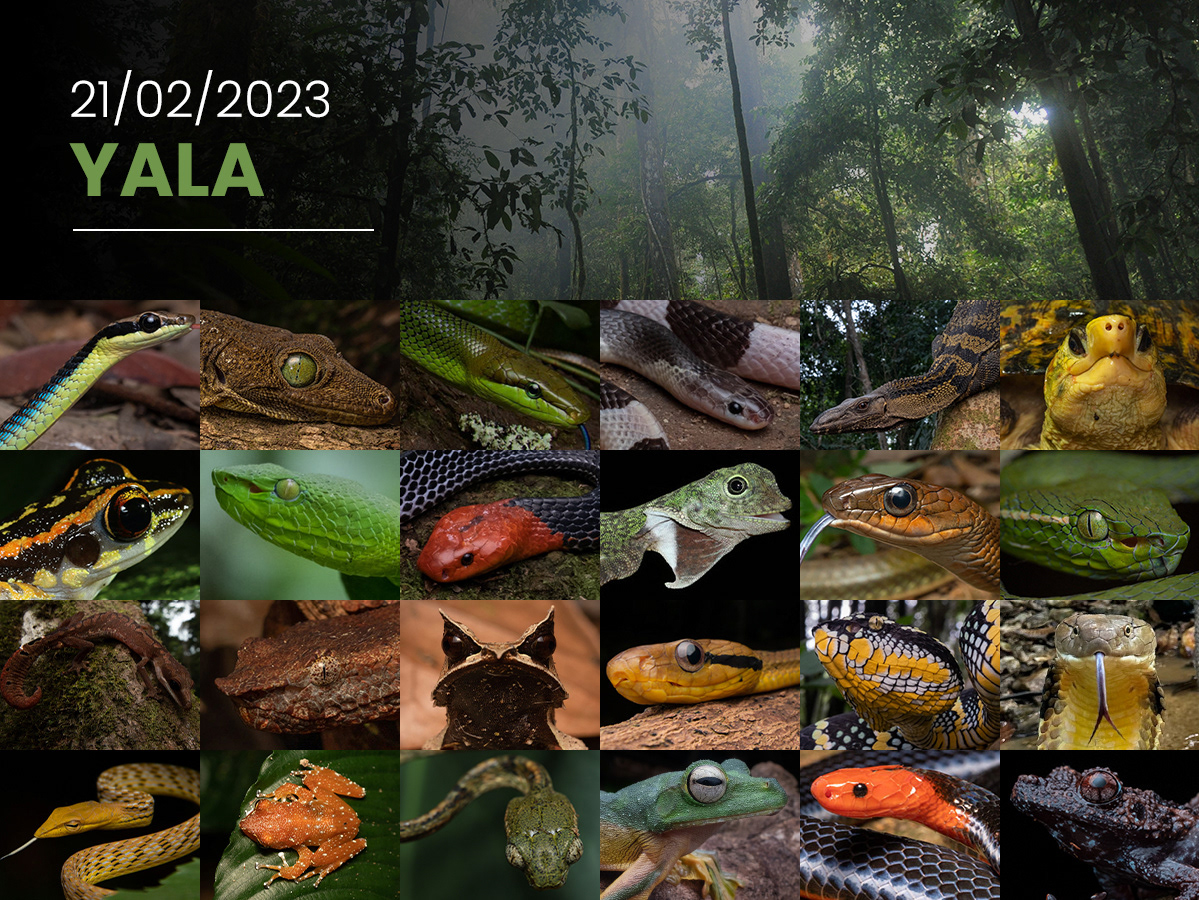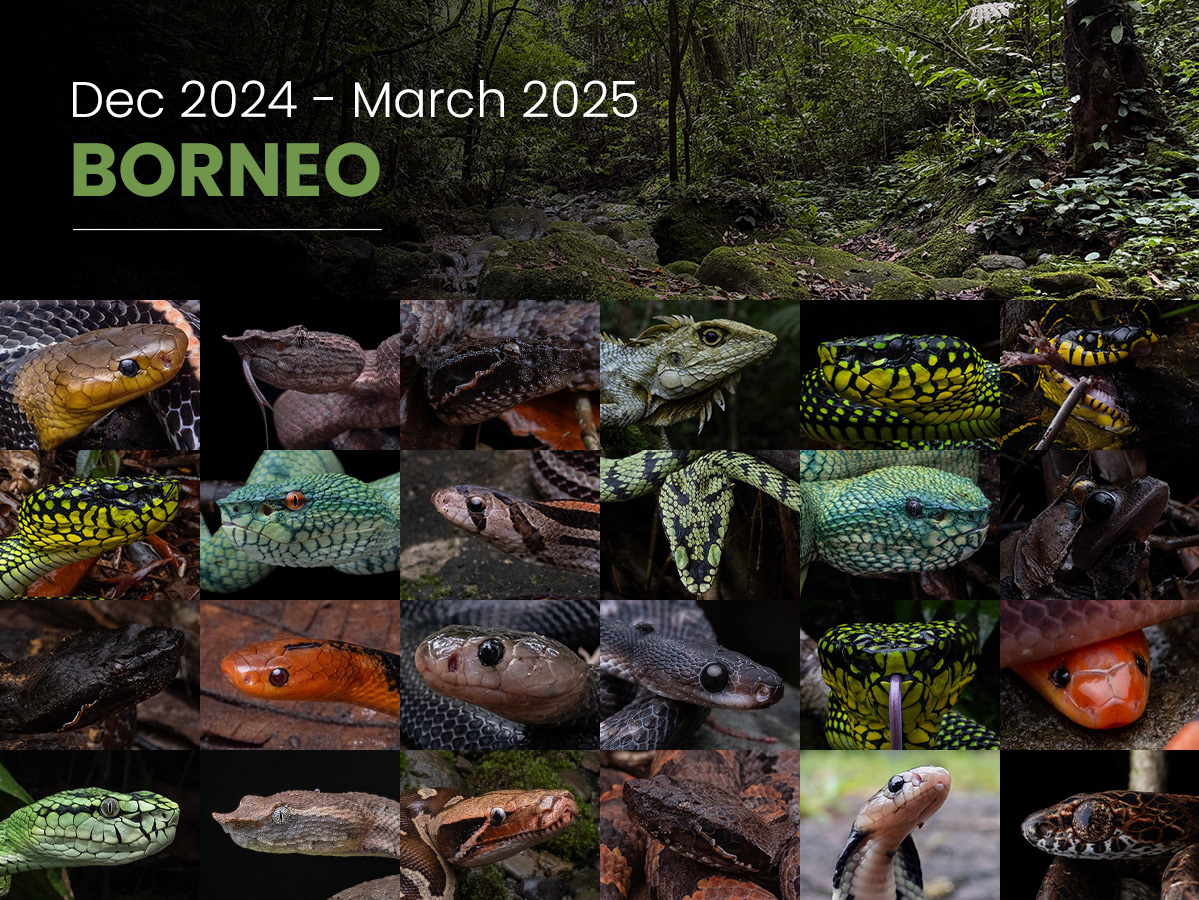Written by Rupert GL
With all our trip reports being from the south of Thailand, it may give the impression that there is nothing exciting in the north. The reality is quite the contrary. Our team had been patiently waiting for the dry season to end so we could explore the vast areas of incredible habitat on offer throughout the rest of the country, which we believe are highly overlooked. Thus, as late June arrived, we headed to south-eastern Thailand with the aim of finding several species of snake endemic to the region (or easier to find there than elsewhere).
The first stop was agricultural lowlands within the province of Sa Kaeo, lying on the border with Cambodia. Our foremost target was the extremely rarely seen Homalopsid, Enhydris chanardi, but we had a few other aspirations, including the Siamese Russell’s viper (Daboia siamensis).
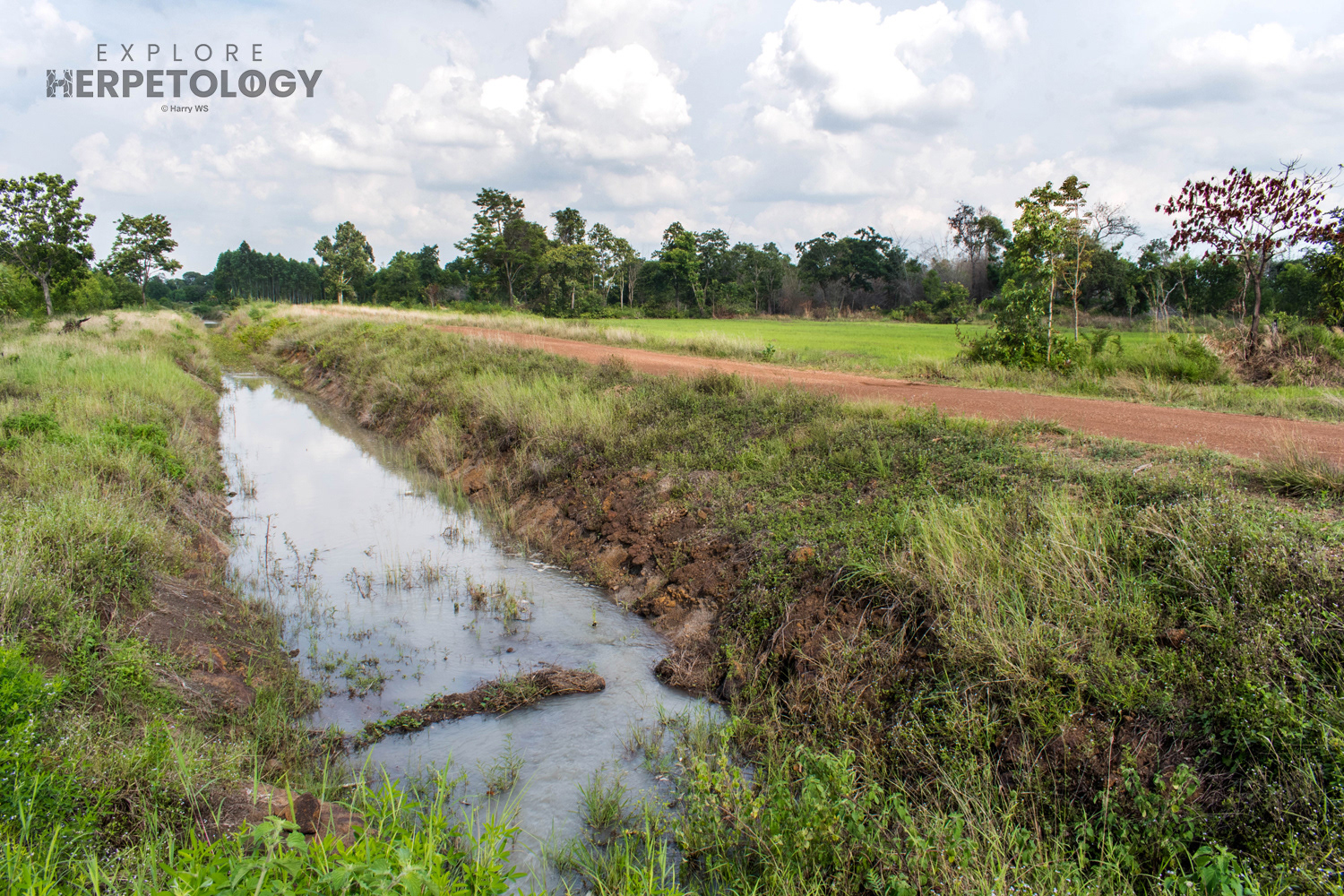
The hunting grounds.
The first day was highly productive for snakes. We saw countless yellow-spotted keelbacks (Fowlea flavipunctatus) and rainbow water snakes (Enhydris enhydris), multiple white-lipped pit-vipers (Trimeresurus albolabris), a long-nosed vine snake (Ahaetulla fusca), and a Malayan krait (Bungarus candidus).

The prettiest Yellow-spotted keelback (Fowlea flavipunctatus) we'd ever seen.

Rainbow water snake (Enhydris enhydris).
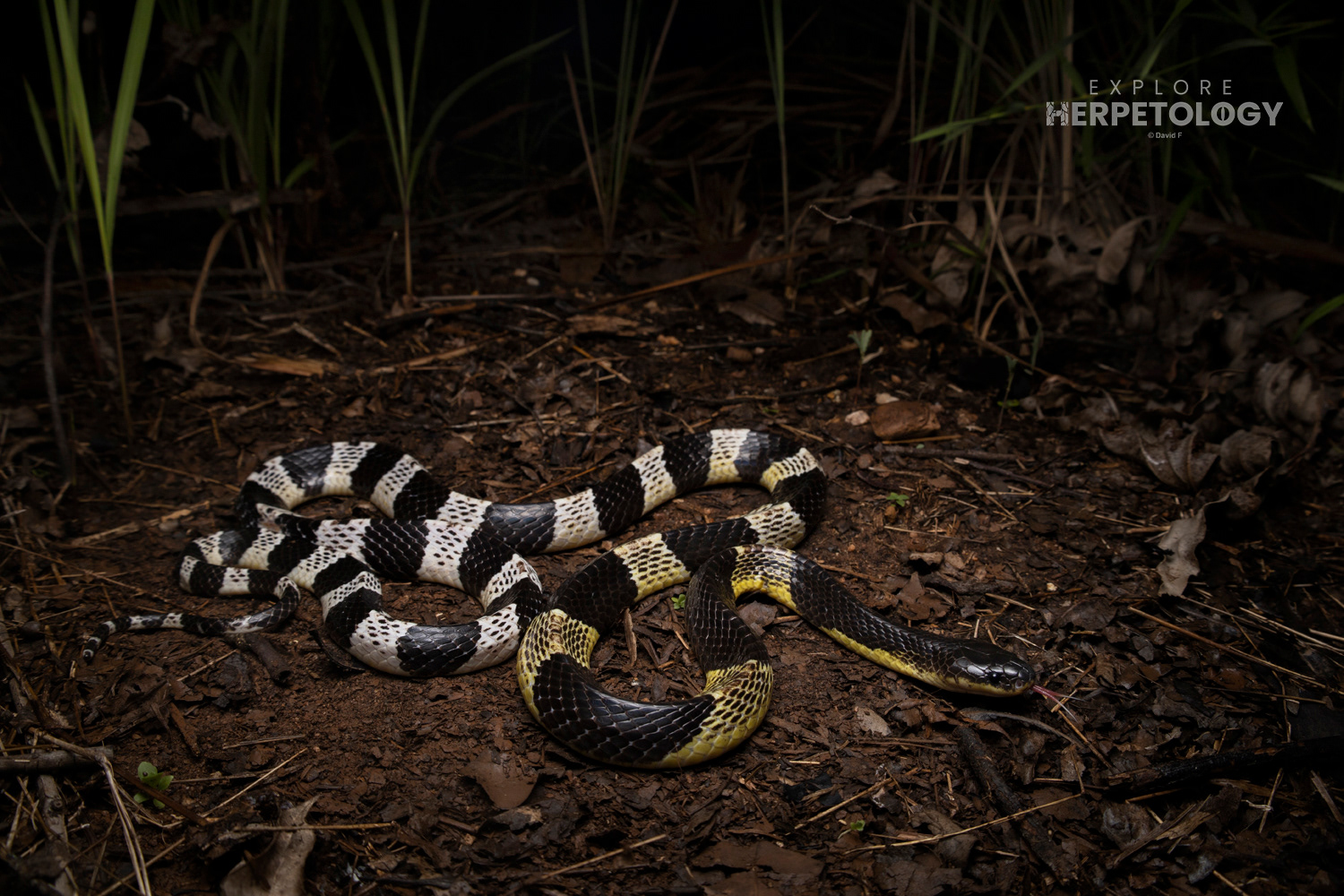
Malayan krait (Bungarus candidus).
The most notable bycatch was a lovely Bocourt’s mud snake (Subsessor bocourti), while the only target species we managed to catch was a striped kukri snake (Oligodon taeniatus). Heartbreakingly, we saw two Enhydris chanardi but both of them slipped away into the murky depths. On the drive back to our accommodation, we encountered a Burmese python (Python bivittatus) which had been hit on the tail by a car.
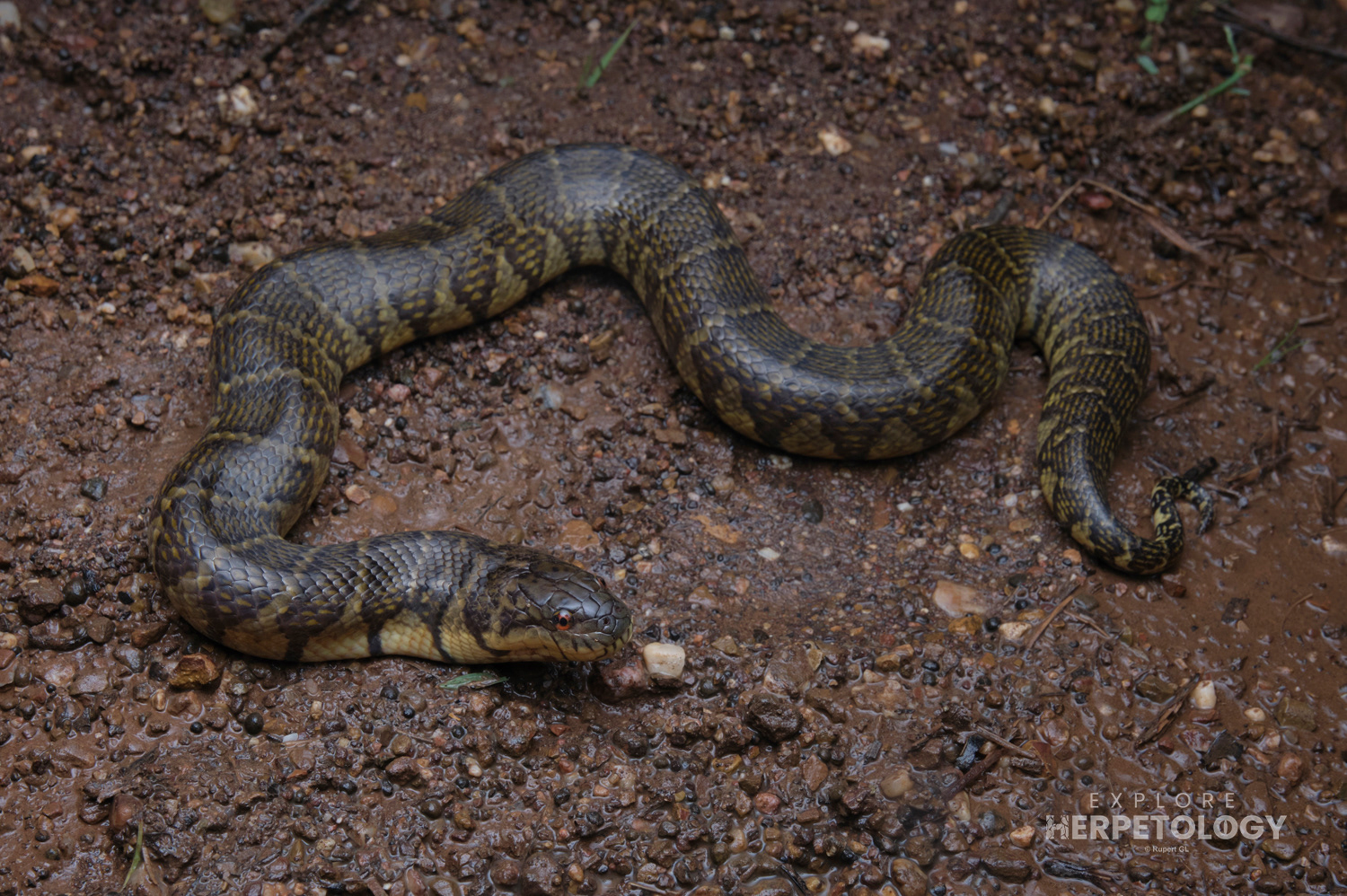
Bocourt’s mud snake (Subsessor bocourti).
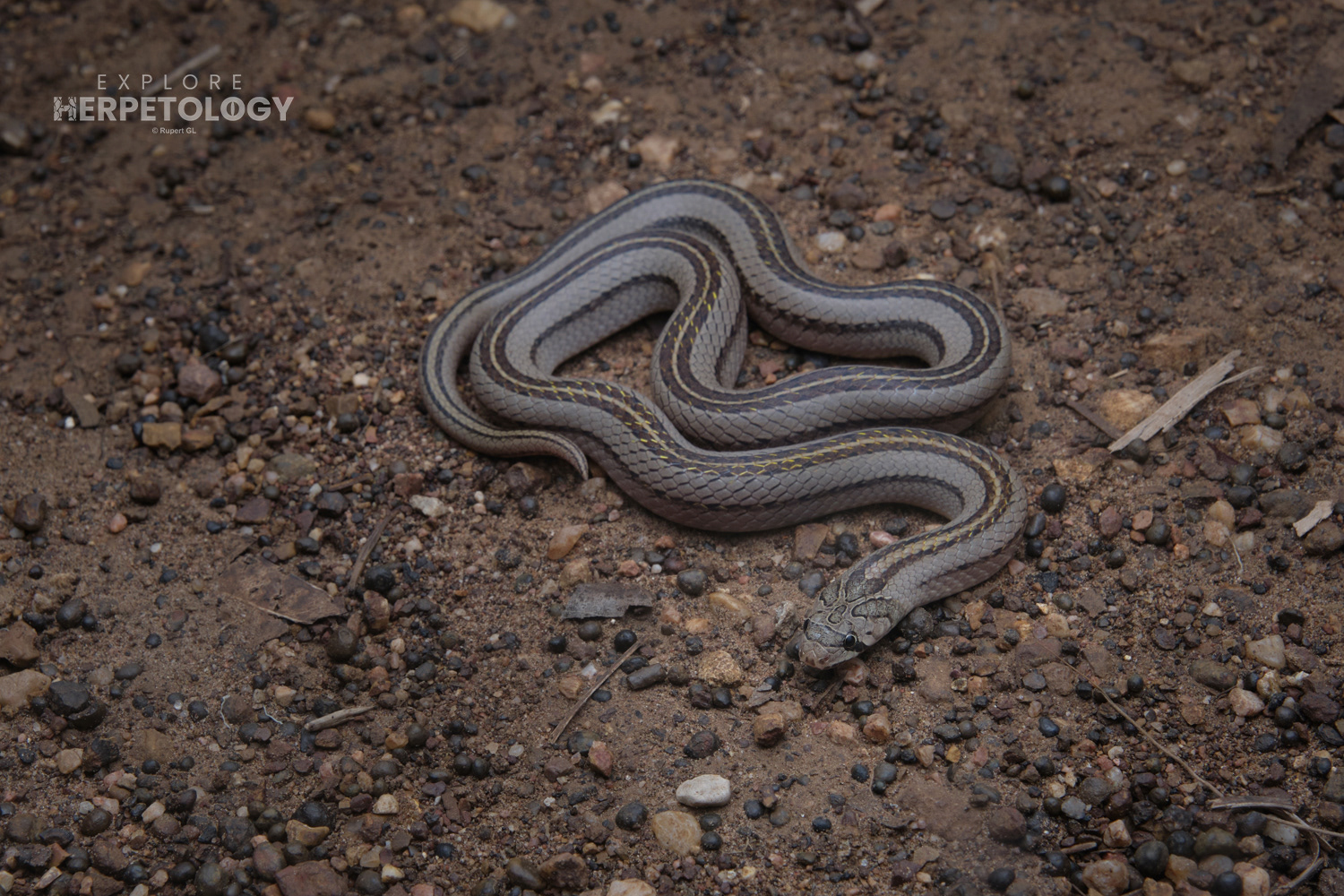
striped kukri snake (Oligodon taeniatus).
We returned to the same area the next day and dedicated ourselves almost exclusively to searching the waters where we saw the two E. chanardi individuals. We saw more Fowlea, over 20 Enhydris enhydris, a sunbeam snake (Xenopeltis unicolor) and one more Subsessor bocourti, but alas not a single sighting of E. chanardi. Miraculously, when morale was low and all hope felt lost, Keith and I stumbled across a juvenile Siamese Russell’s viper (Daboia siamensis) crossing the dirt path in front of our car.

Sunbeam snake (Xenopeltis unicolor).
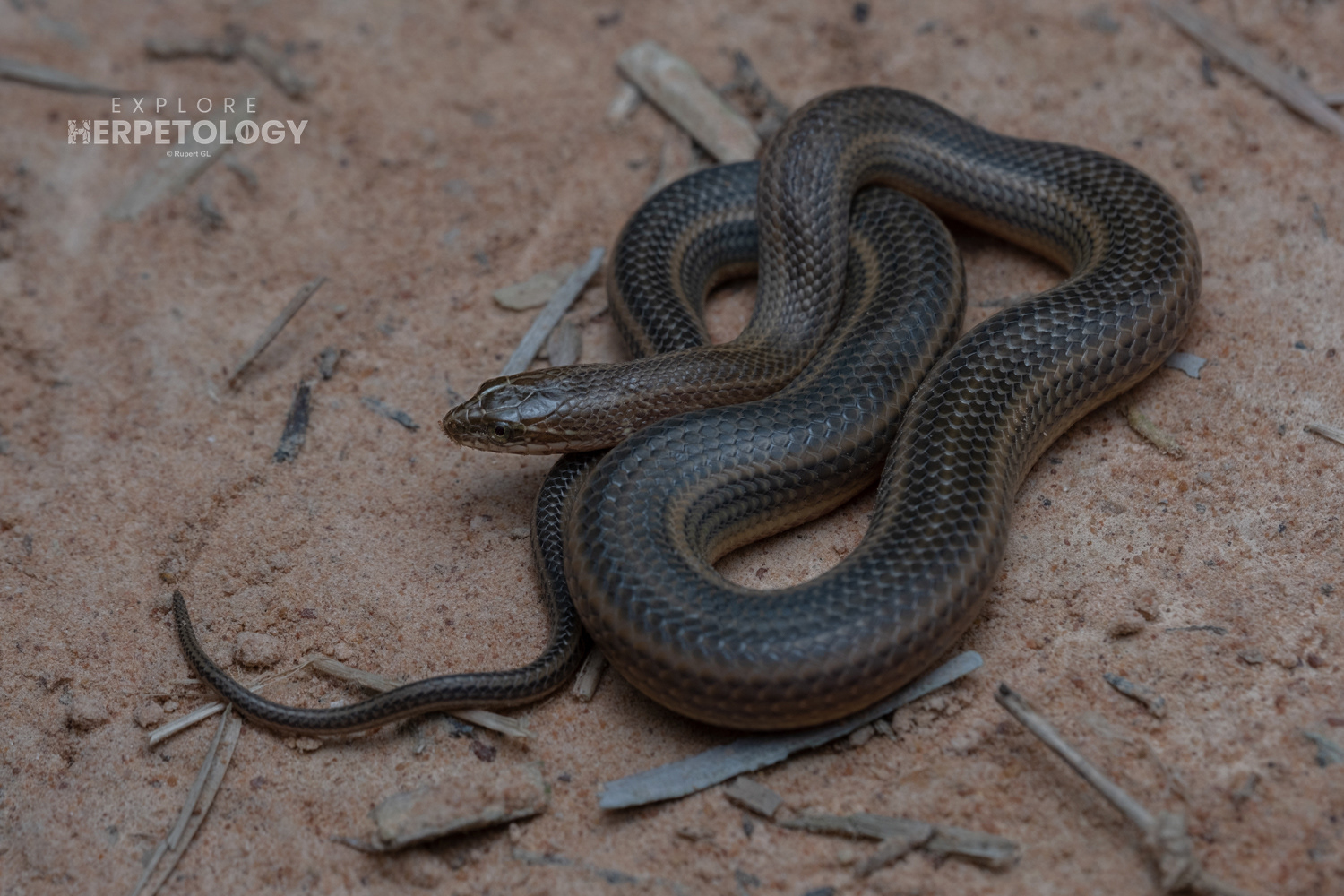
Enhydris enhydris
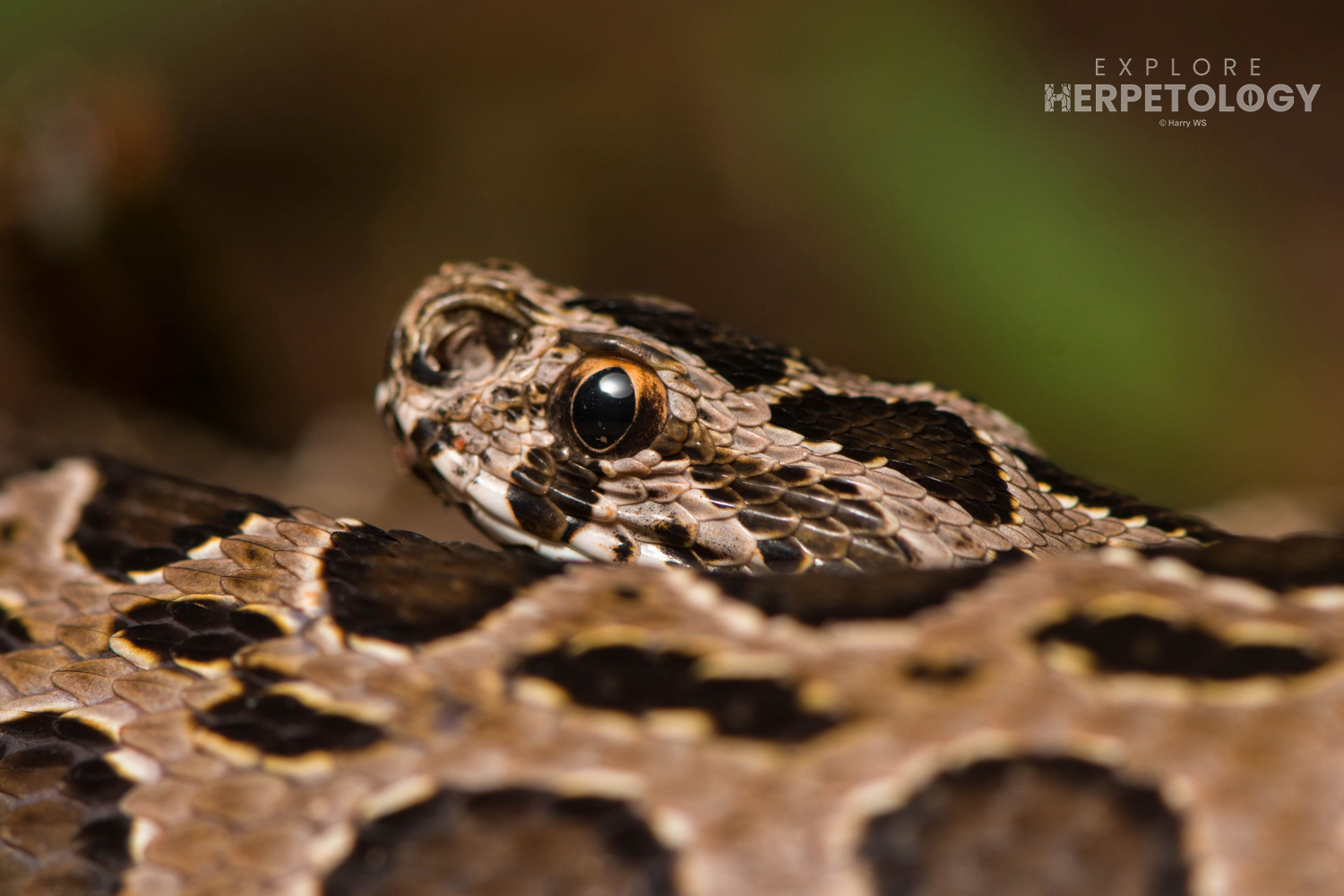
Siamese Russell’s viper (Daboia siamensis).

Siamese Russell’s viper (Daboia siamensis).
Finding 2 of our 3 major targets was a good start to the expedition, and although we weren’t finished with Enhydris chanardi, we had a lot of ground to cover. Thus, we headed south from Sa Kaeo to Chanthaburi province, and more specifically the western extent of the Cardamom Mountains where we had several target species to attack.
Our first night at an area of mature low-hill forest was incredibly successful. We found the trifecta of juvenile, adult female, and adult male Cardamom pit-vipers (Trimeresurus cardamomensis), along with our two crucial colubrid targets in the area, a Cardamom Mountains wolf snake (Lycodon cardamomensis) and a Nganson bronzeback (Dendrelaphis ngansonensis).
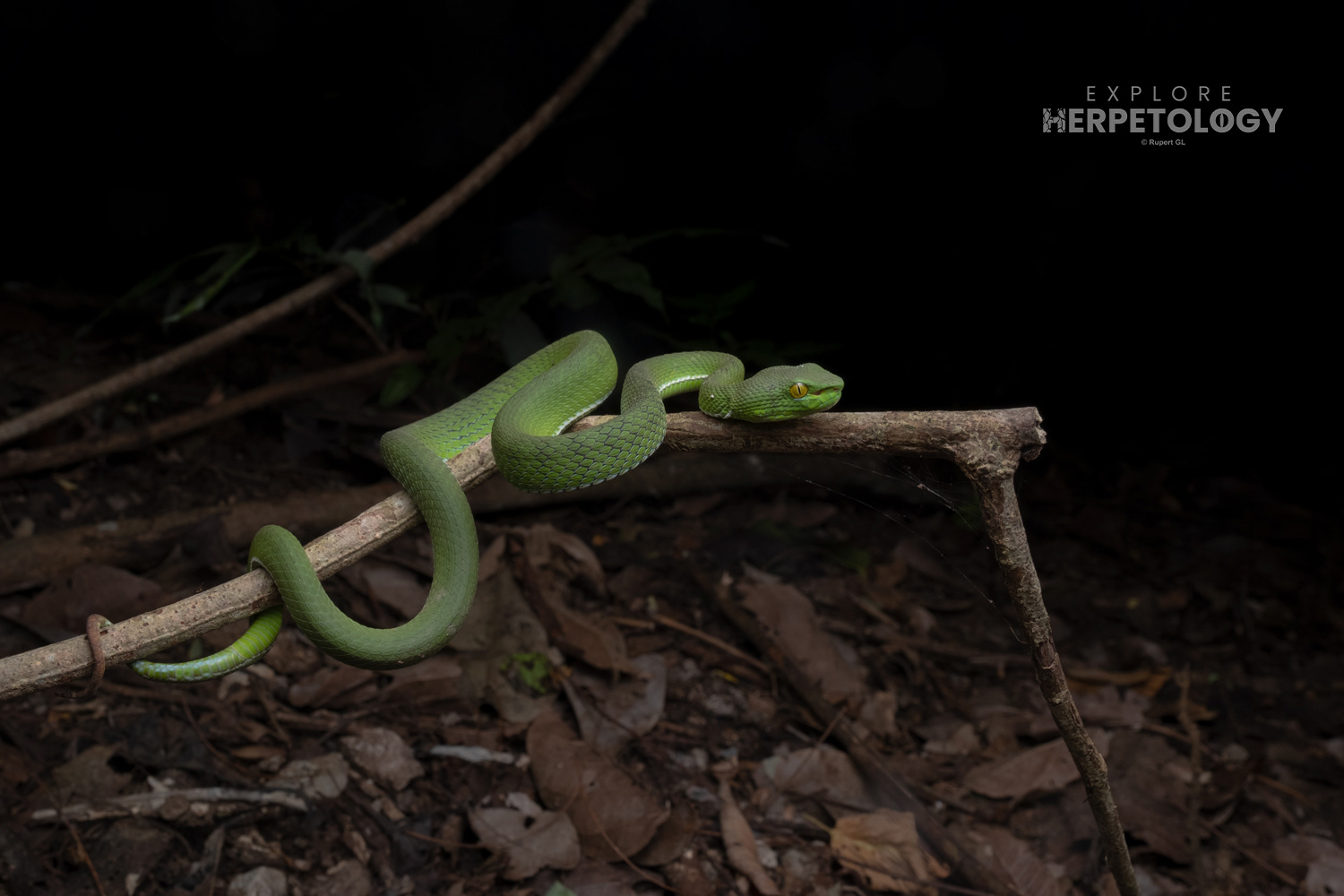
Cardamom pit-viper (Trimeresurus cardamomensis) female.
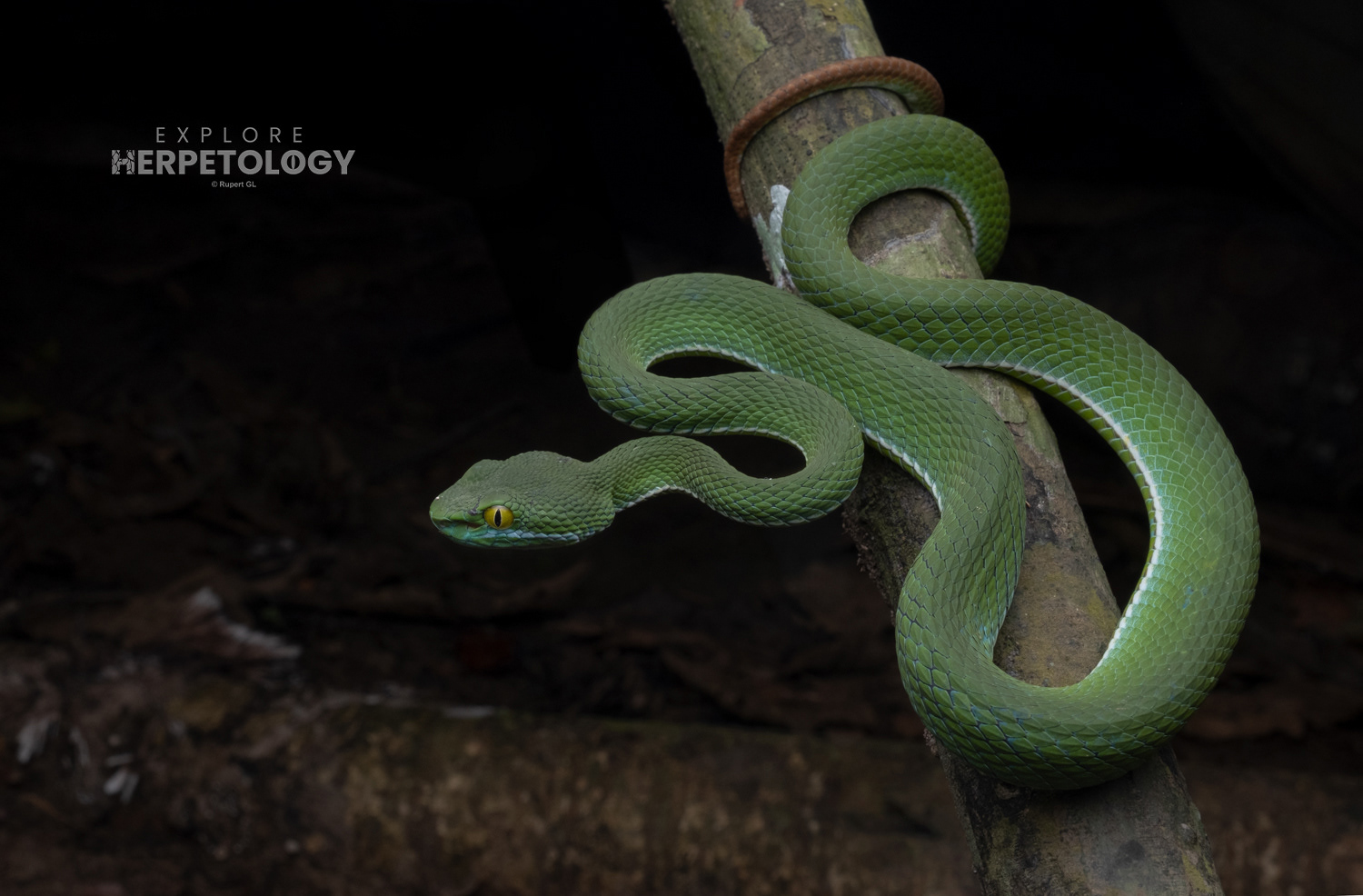
Cardamom pit-viper (Trimeresurus cardamomensis) male.
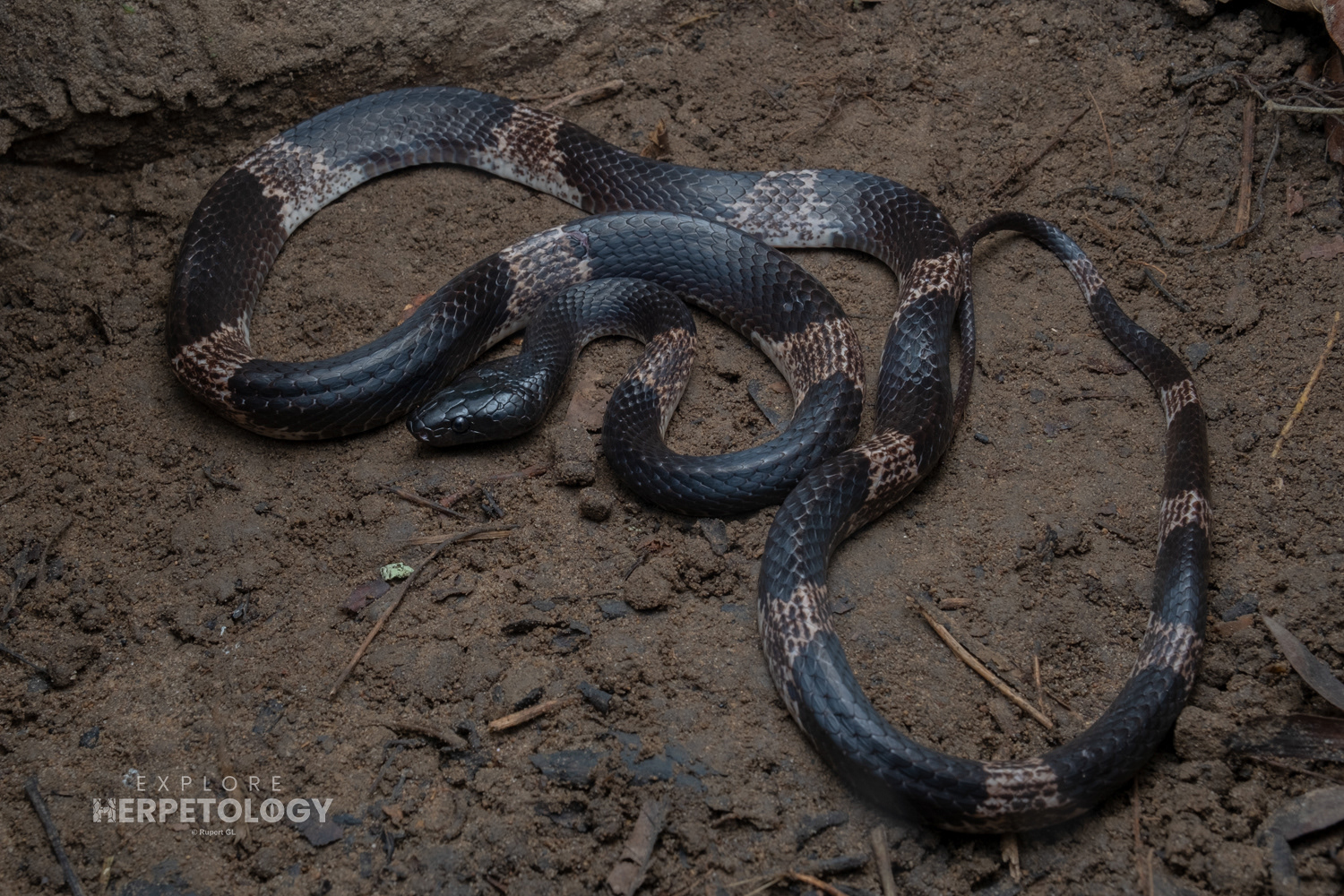
Cardamom Mountains wolf snake (Lycodon cardamomensis).
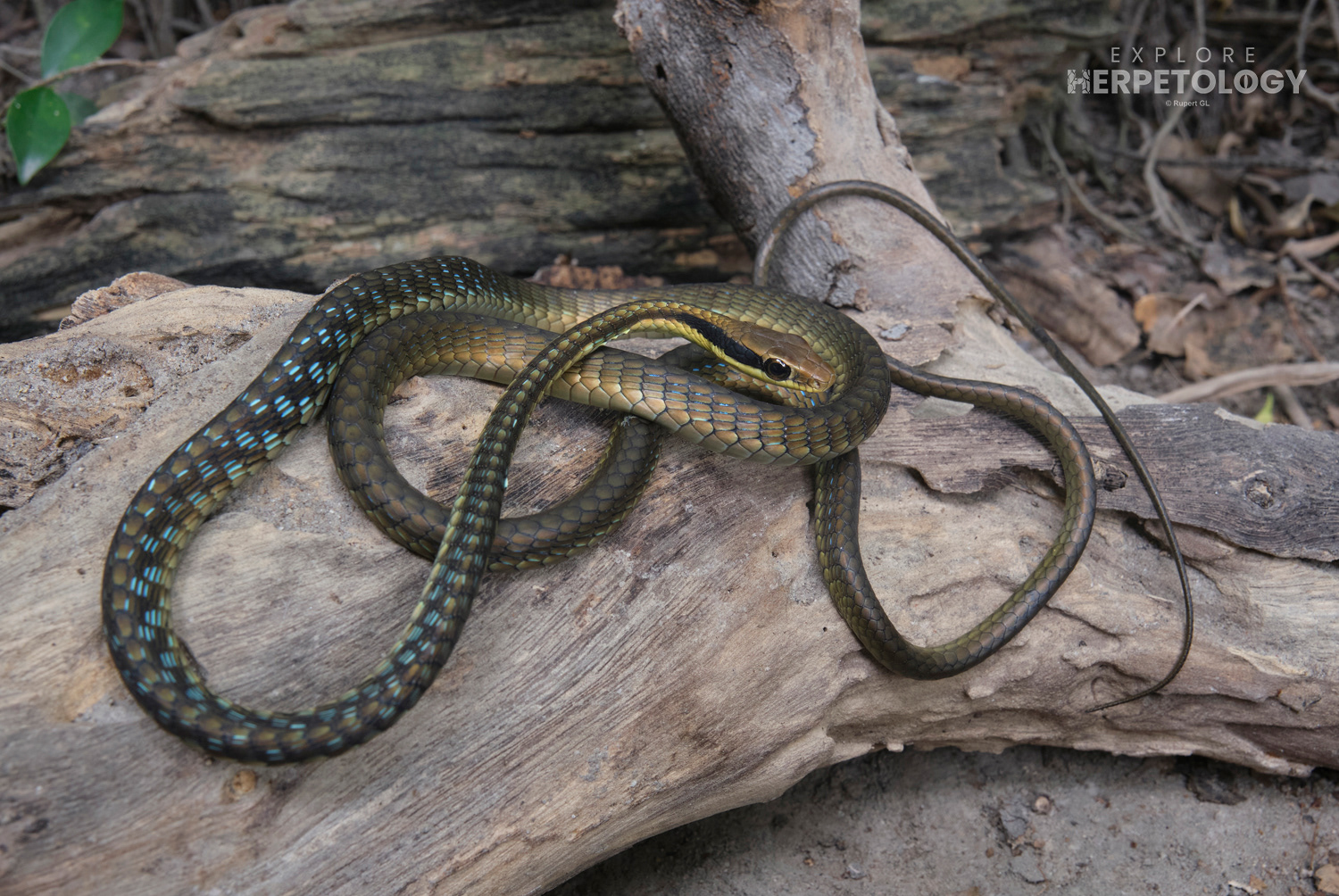
Nganson bronzeback (Dendrelaphis ngansonensis).
After a refreshing 1am dip in a giant waterfall, we ascended an extremely steep hillside in order to get high enough in altitude to find Trimeresurus vogeli. It did not take long until we found a simply jaw-dropping adult male individual, concluding a simply fantastic night in the field.
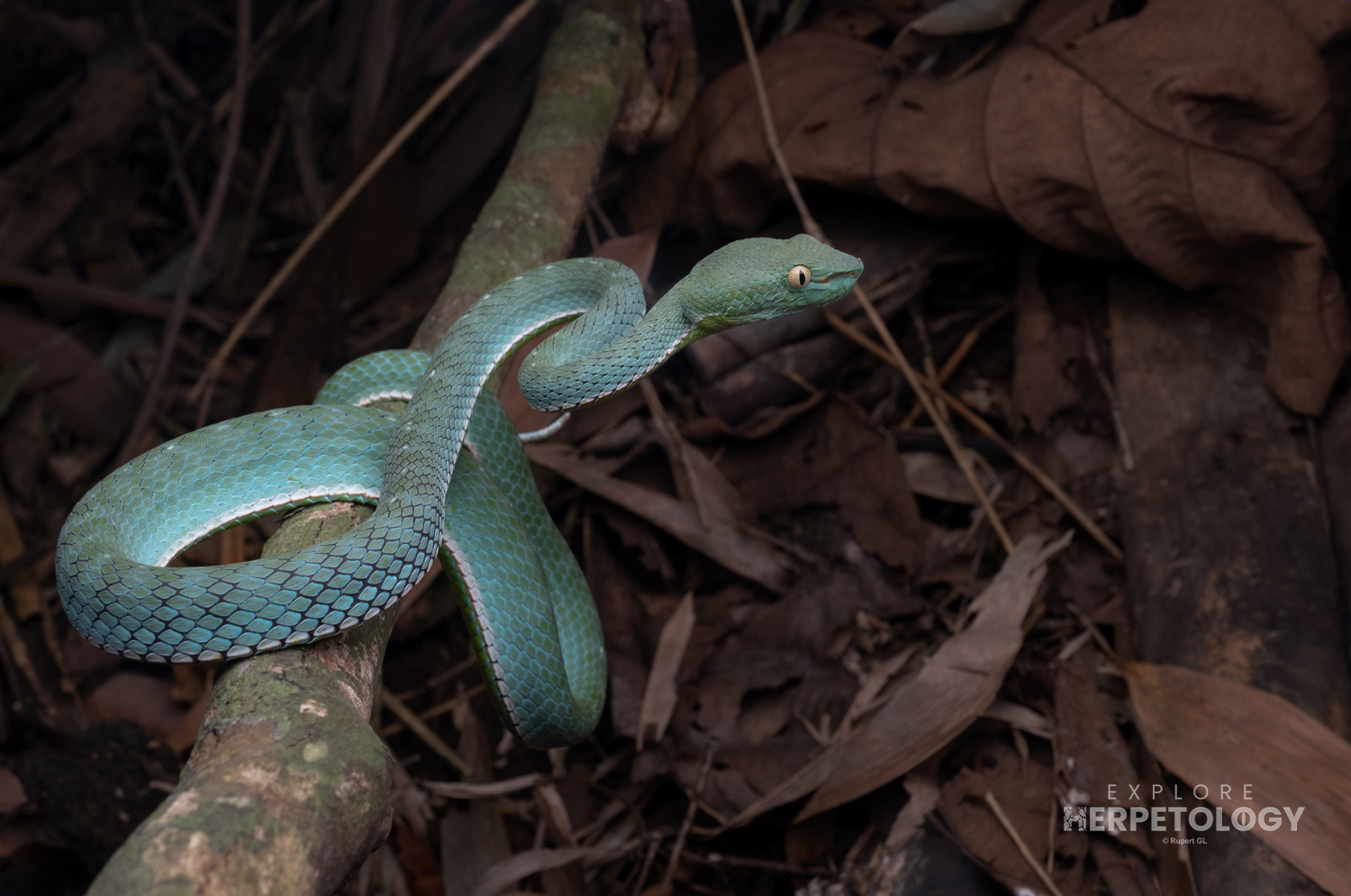
Vogel's pit viper (Trimeresurus vogeli) male.
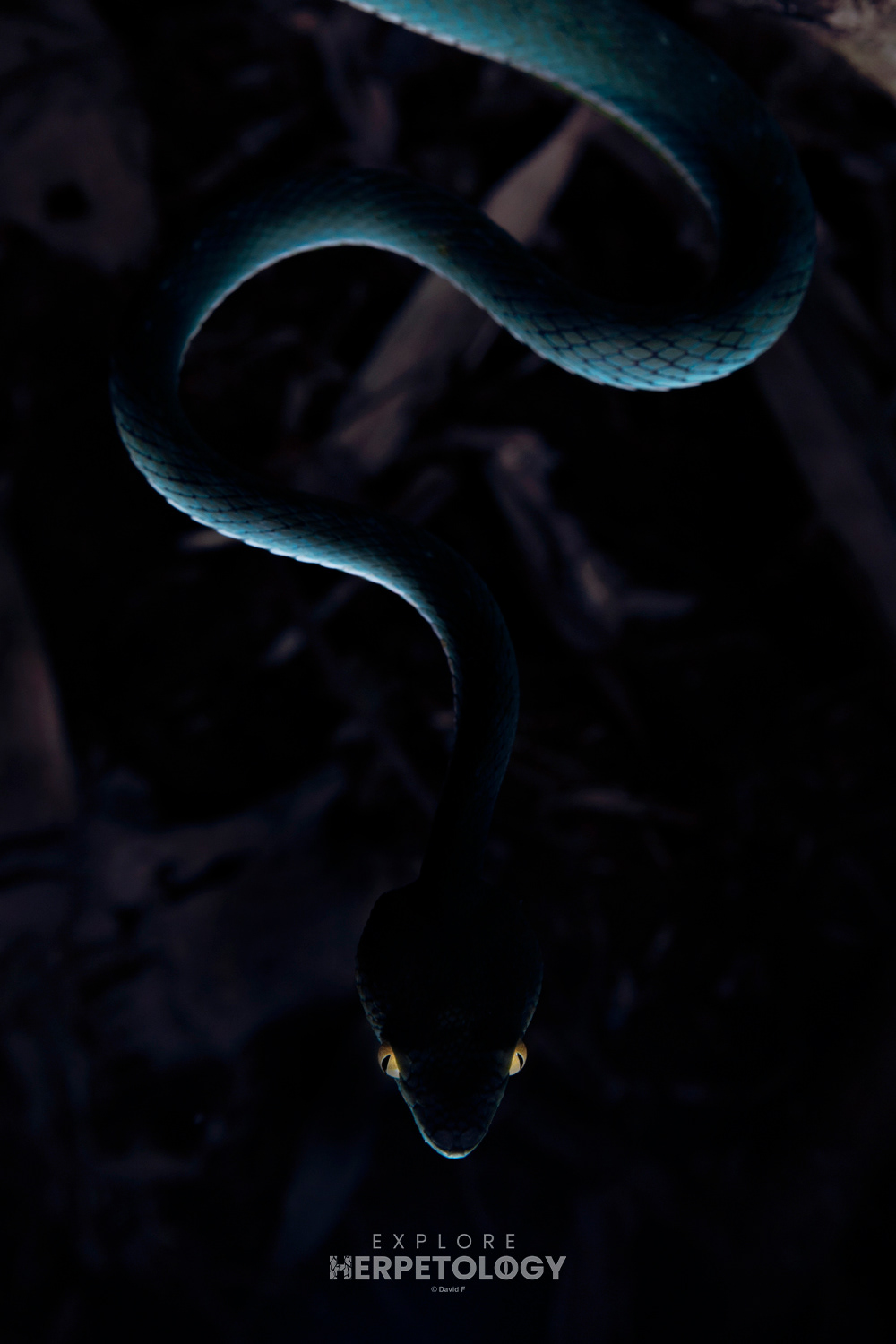
Trimeresurus vogeli.
Serpentine bycatch from this evening included another Malayan krait (Bungarus candidus), a mock viper (Psammodynastes pulverulentus) and a berdmore’s slug snake (Pareas berdmorei).
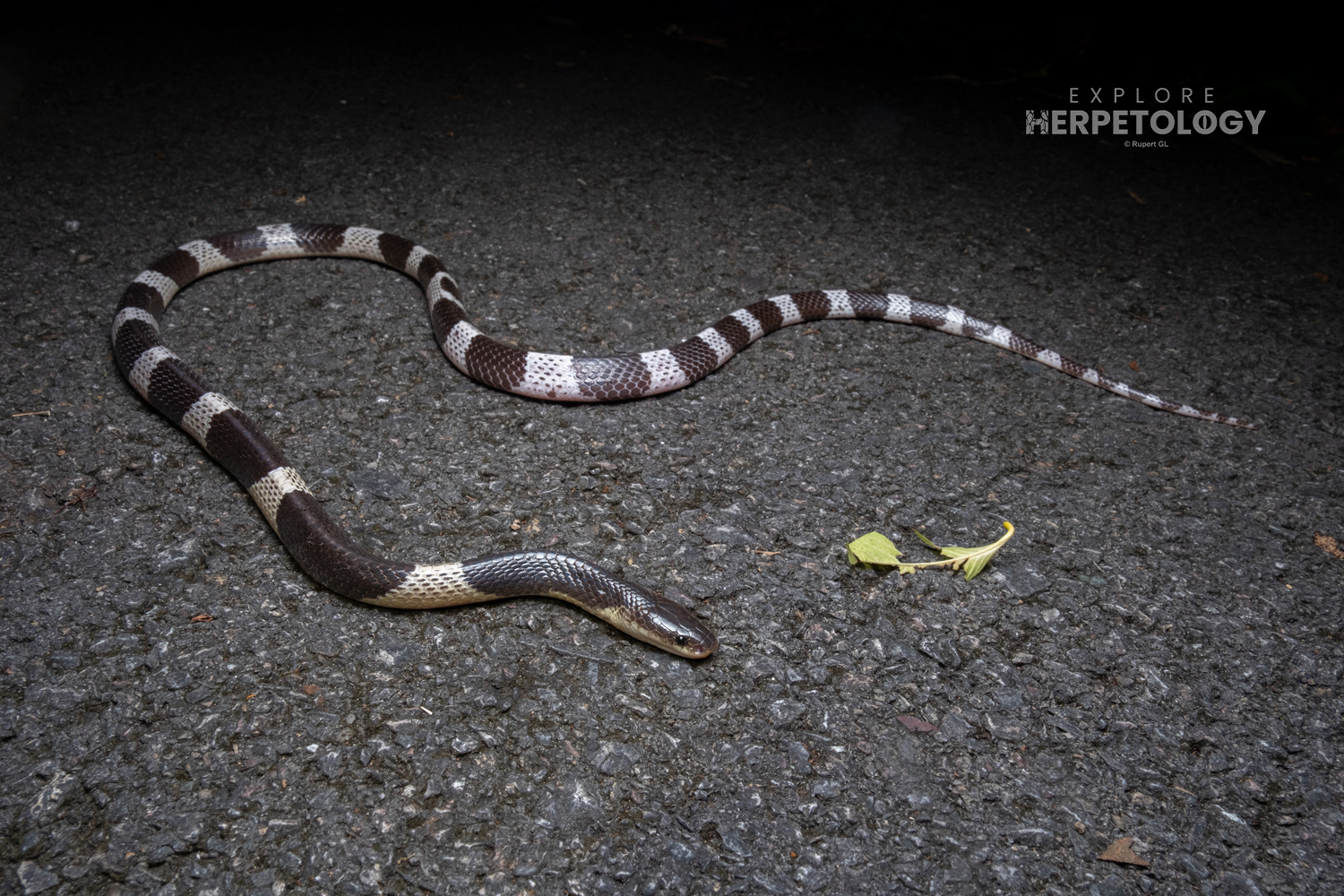
Malayan krait (Bungarus candidus).

Mock viper (Psammodynastes pulverulentus).
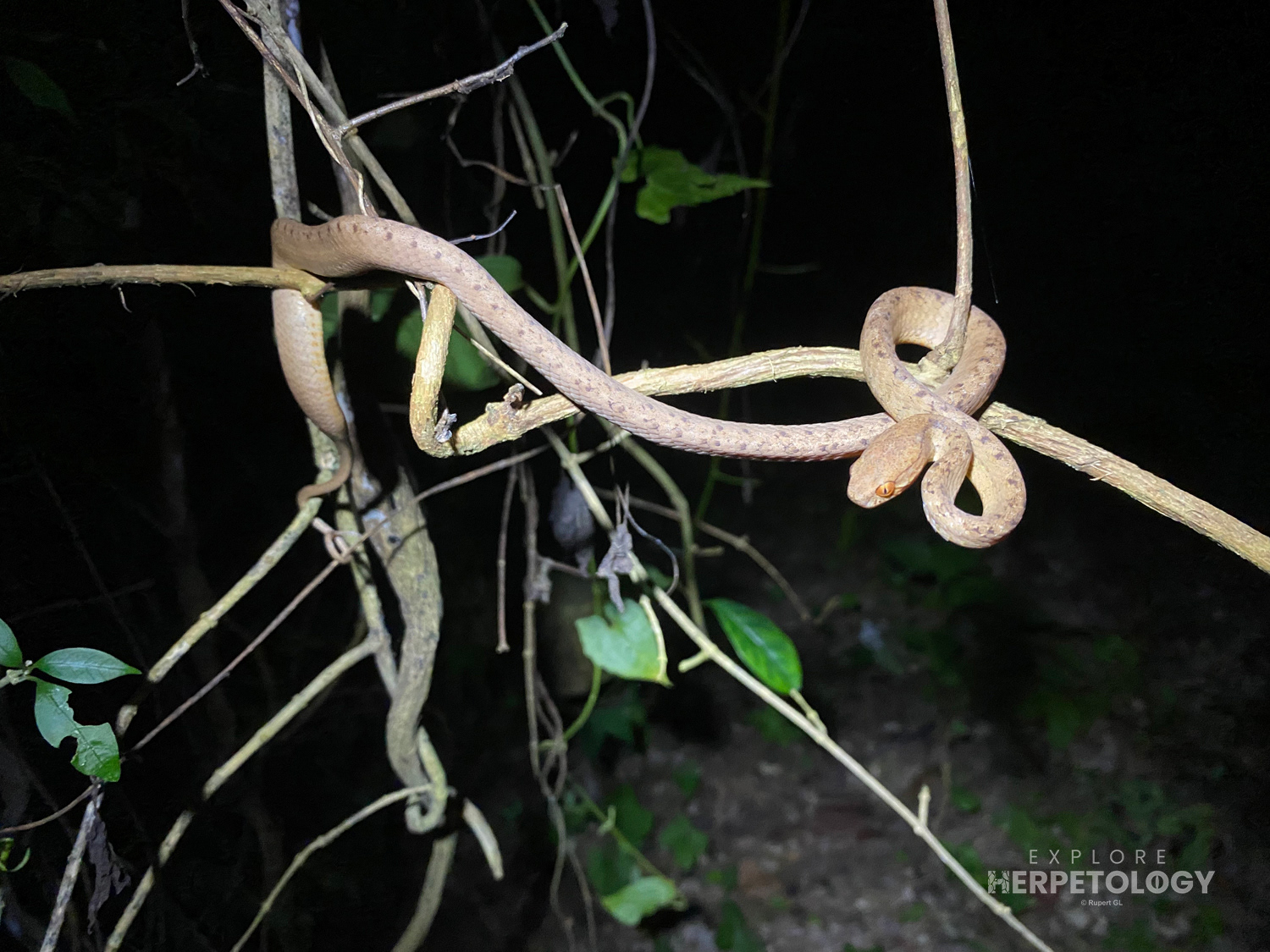
Berdmore’s slug snake (Pareas berdmorei).
We also encountered several lizards at this location, including multiple Chanthaburi rock geckos (Cnemaspis chanthaburiensis) and intermediate bent-toed geckos (Cyrtodactylus), as well as a few Burmese green crested lizard (Bronchocela burmana) and one single adult Chinese water dragon (Physignathus cocincinus).

Chanthaburi rock geckos (Cnemaspis chanthaburiensis).
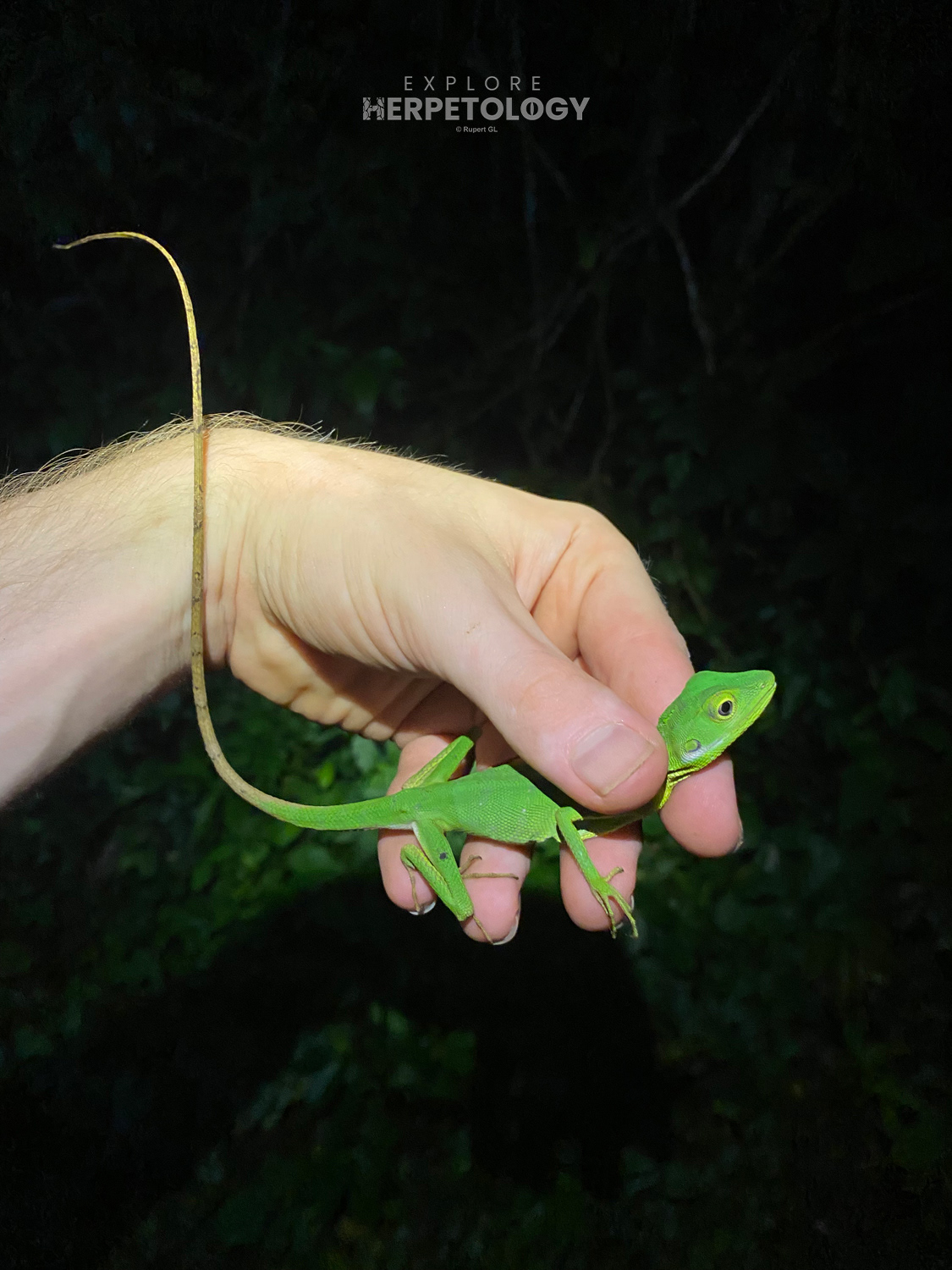
Burmese green crested lizard (Bronchocela burmana).

Intermediate bent-toed geckos (Cyrtodactylus).
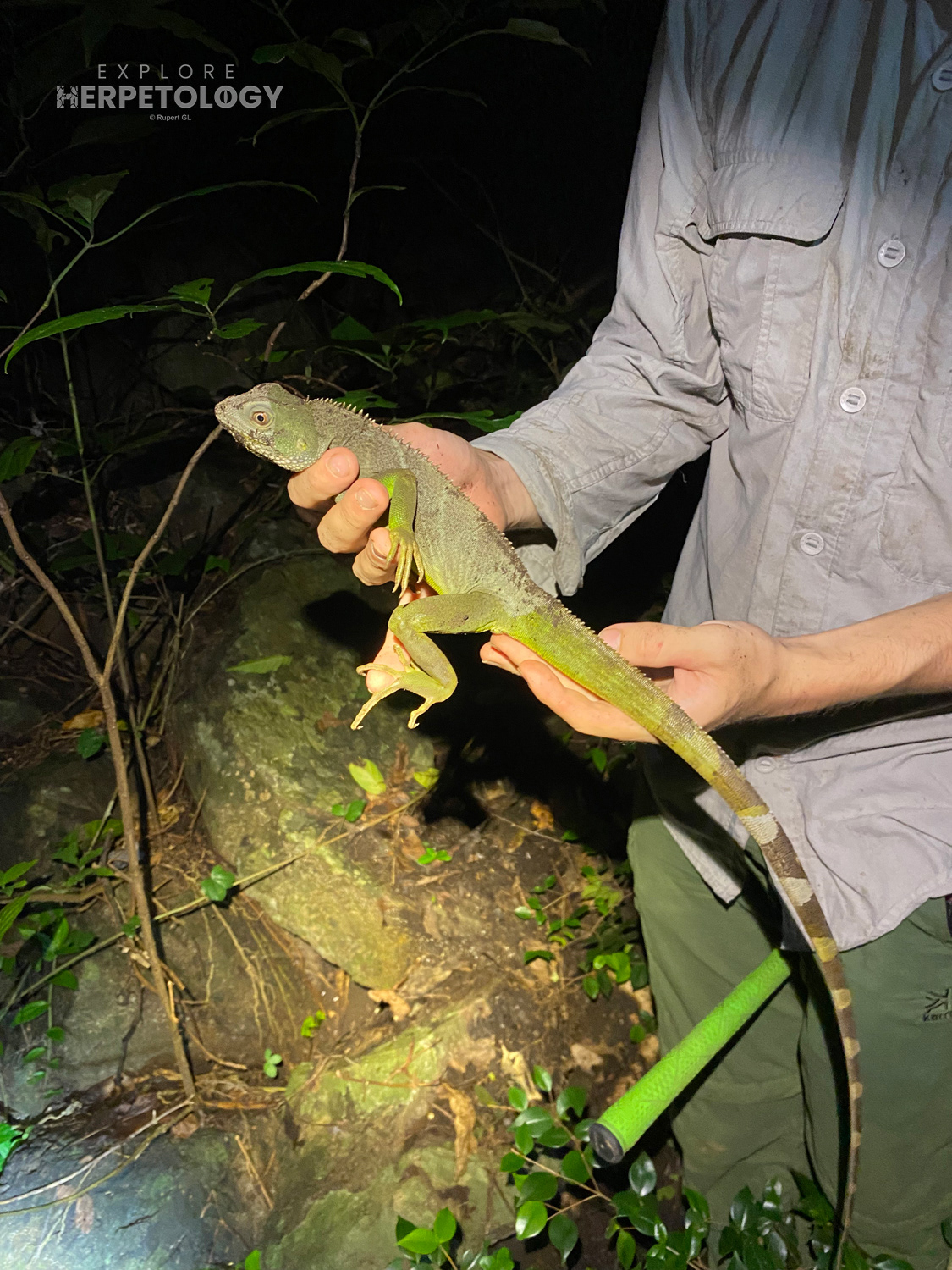
Chinese water dragon (Physignathus cocincinus).
The following day, we headed further south in Chanthaburi to access some higher elevation evergreen forest. The early part of the evening was spent hiking up to a rocky stream in the hills. The rainy day and dry nights made for perfect herping conditions, and we had another exceptional foray into the forest.
Remarkably, we found 4 Malayan kraits (Bungarus candidus), breaking my long-standing record for most kraits in one night (previously 3 on several occasions). Additionally, we found two more huge Cardamom Mountains wolf snakes (Lycodon cardamomensis) which had a more orange banding at this location.
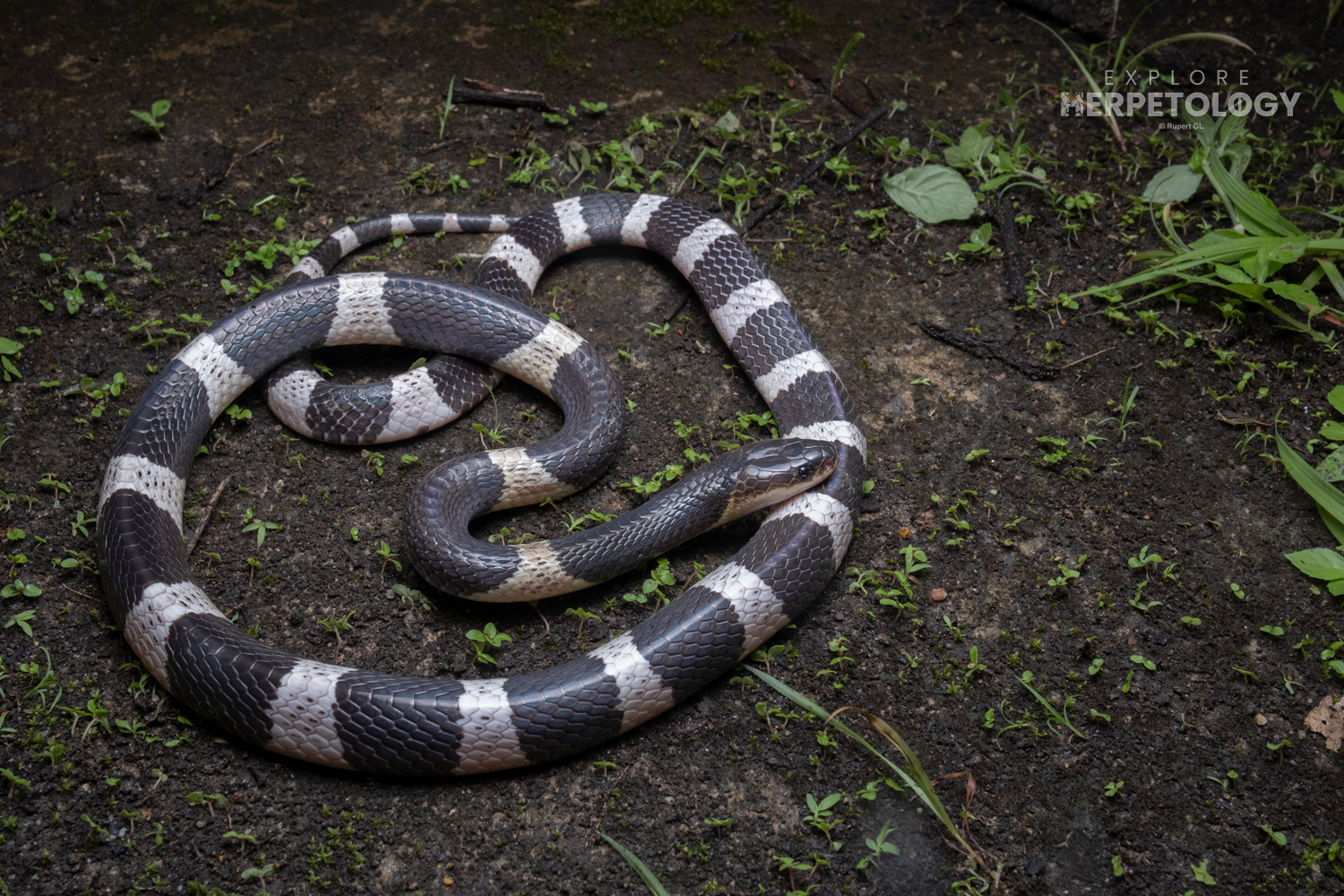
Malayan krait (Bungarus candidus).
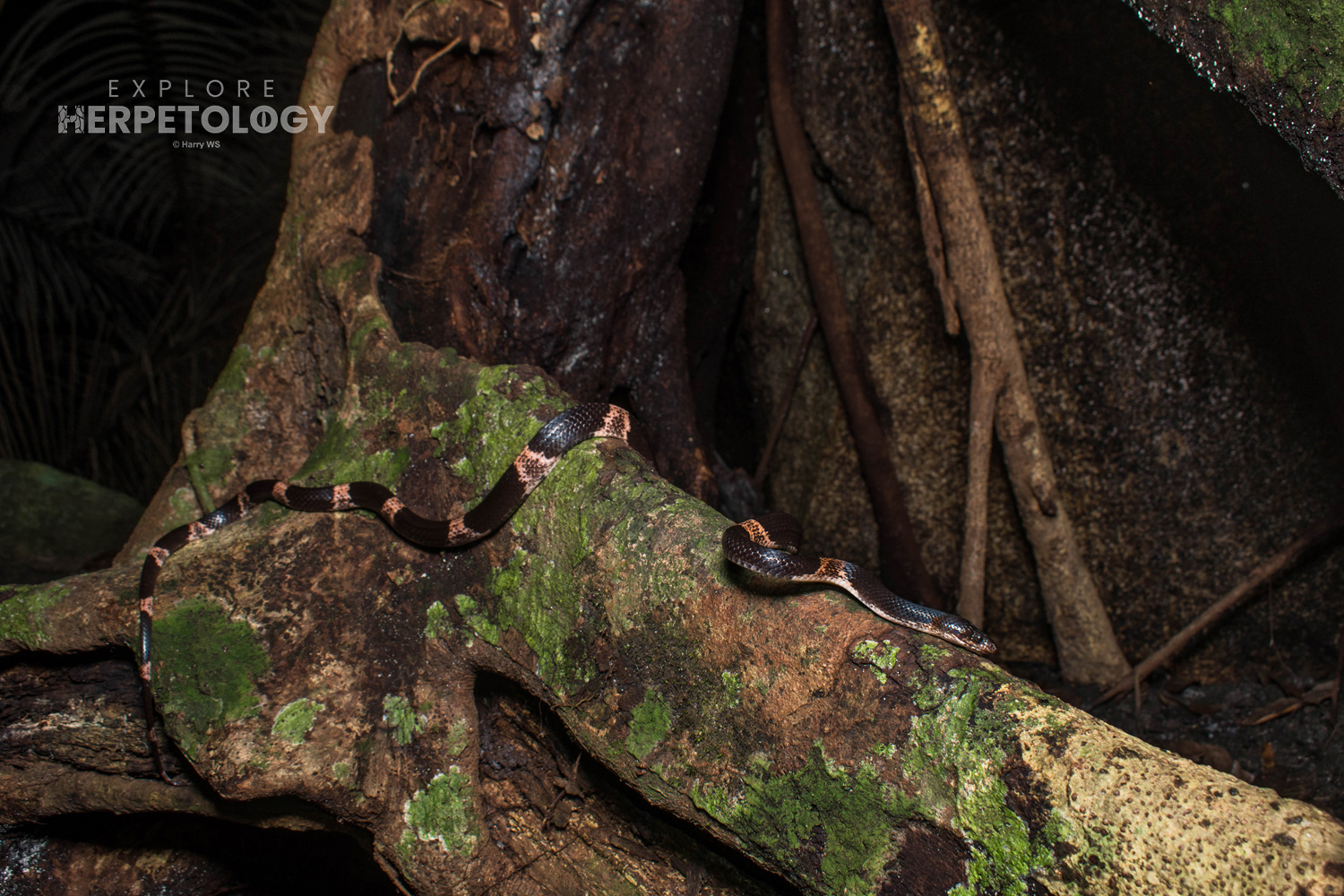
Cardamom Mountains wolf snake (Lycodon cardamomensis) in-situ.

Cardamom Mountains wolf snake (Lycodon cardamomensis).
An Indo-Chinese rat snake (Ptyas korros) was a surprising encounter, but it wasn’t until we hiked higher up the stream that we smashed our number 1 target for the night. Swimming in a small pool beside the stream was a massive Boulenger’s keelback (Hebius boulengeri), an uncommon species restricted to the hills in south-eastern Thailand. This was the shortest night of herping on this trip as we needed to rest substantially for the following evening.
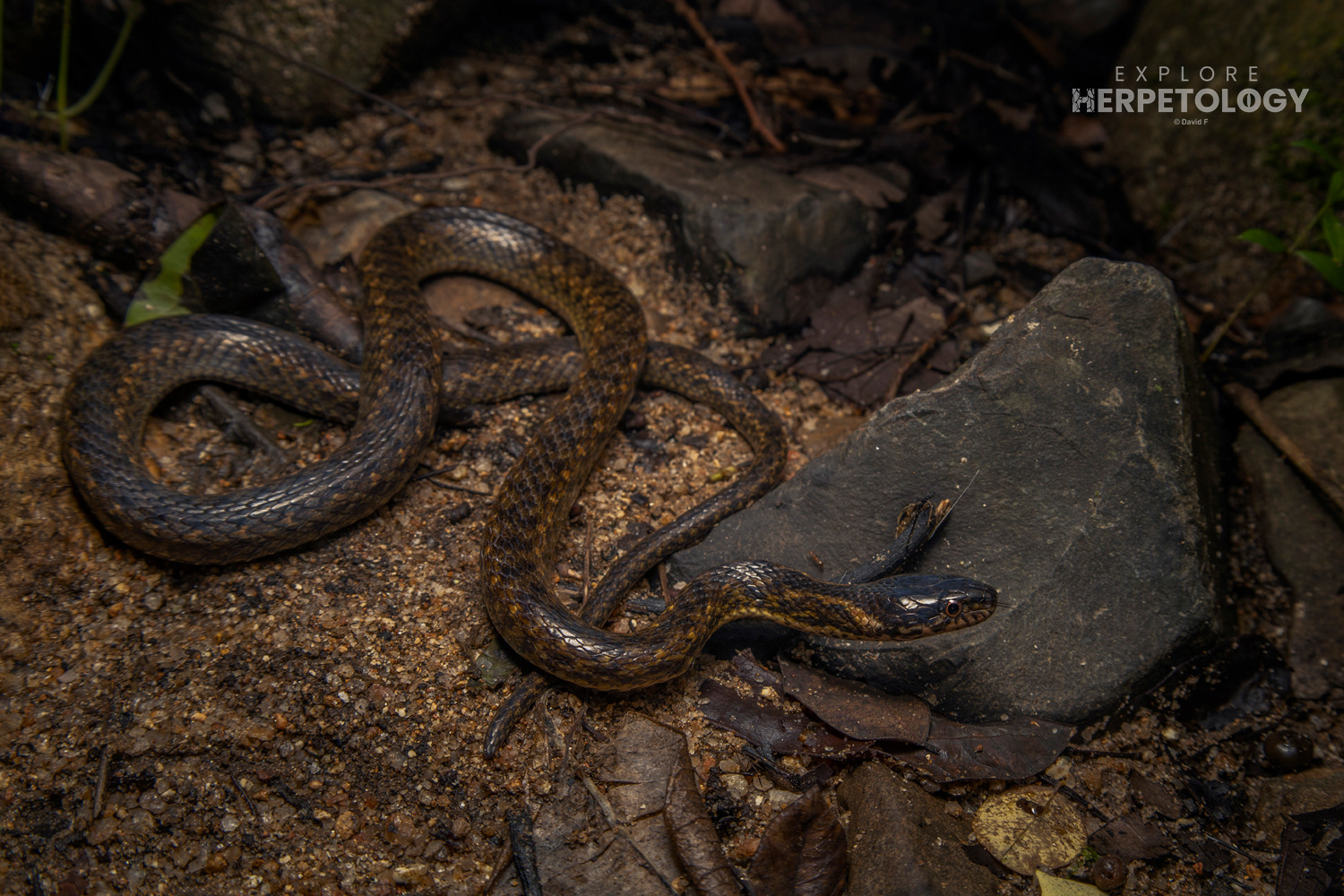
Hebius boulengeri.
After finding all our nocturnal low/mid hills target species, we undertook a serious hike up to submontane elevations and back down in one night. En route to the top of the mountain, we encountered a Siamese red-necked keelback (Rhabdophis siamensis), 2 green cat snakes (Boiga cyanea), a reticulated python (Malayopython reticulatus) and a grey morph oriental vine snake (Ahaetulla prasina). The best find of the night was an adult female Vogel’s pit-viper (Trimeresurus vogeli).
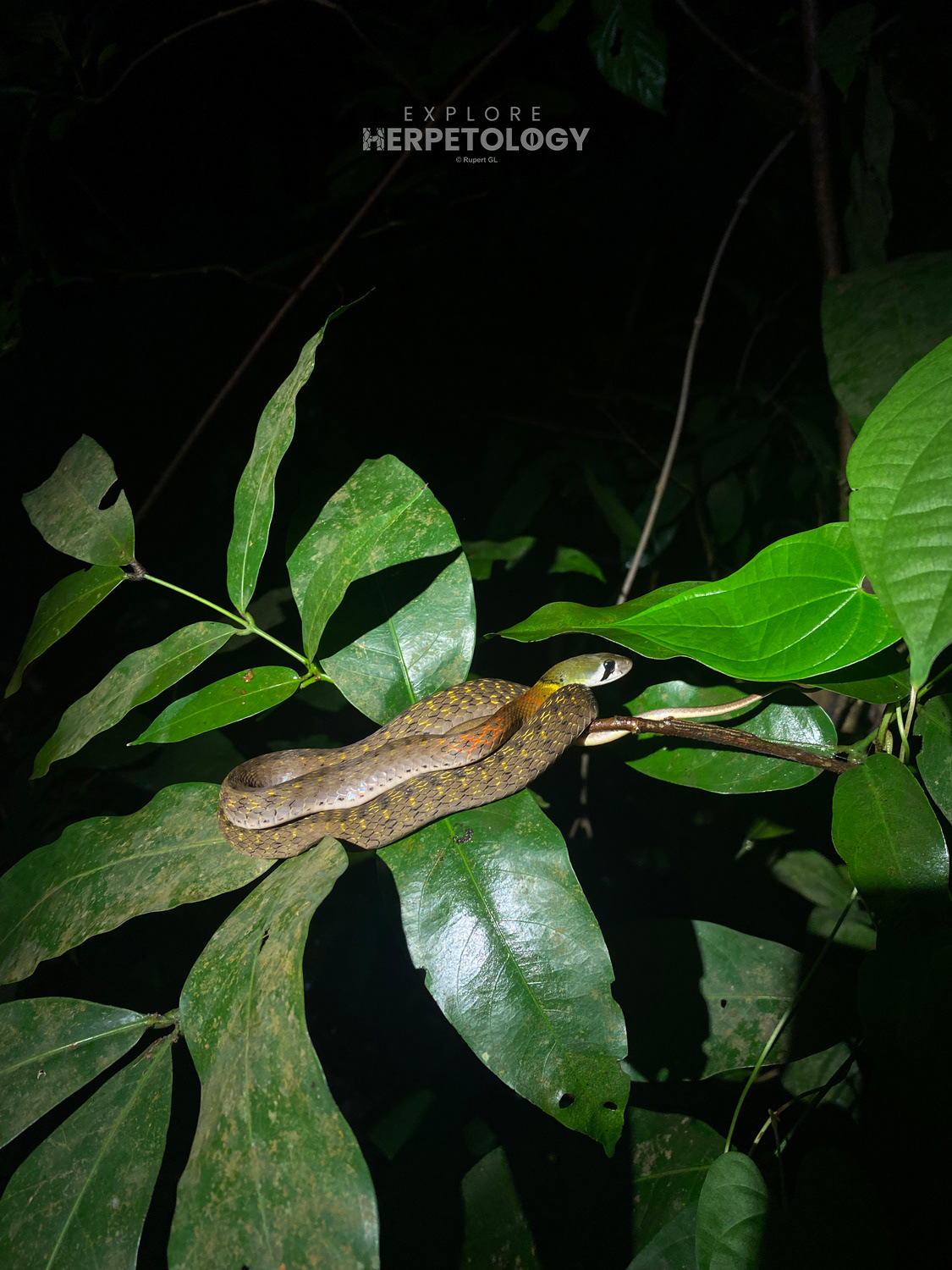
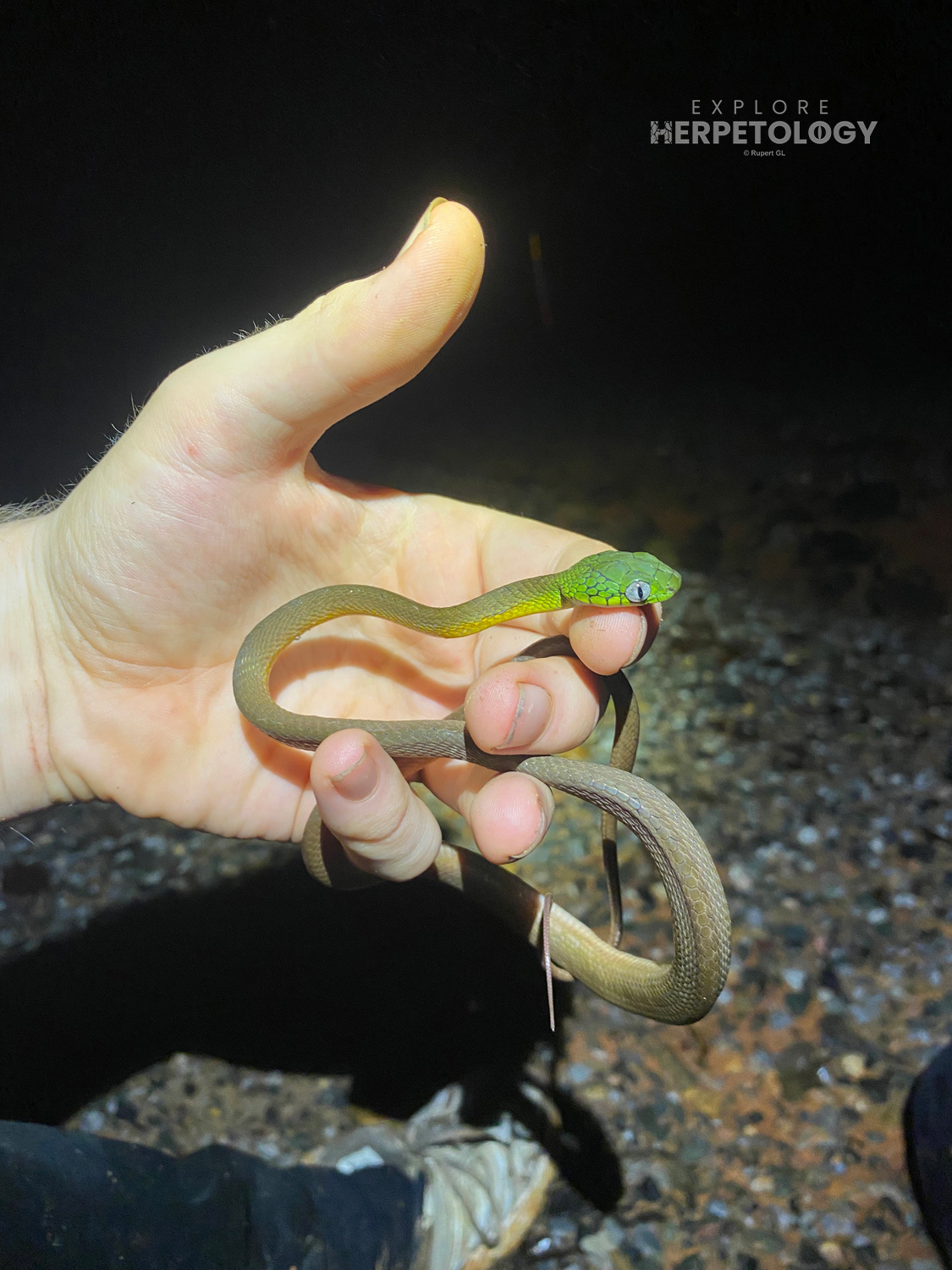
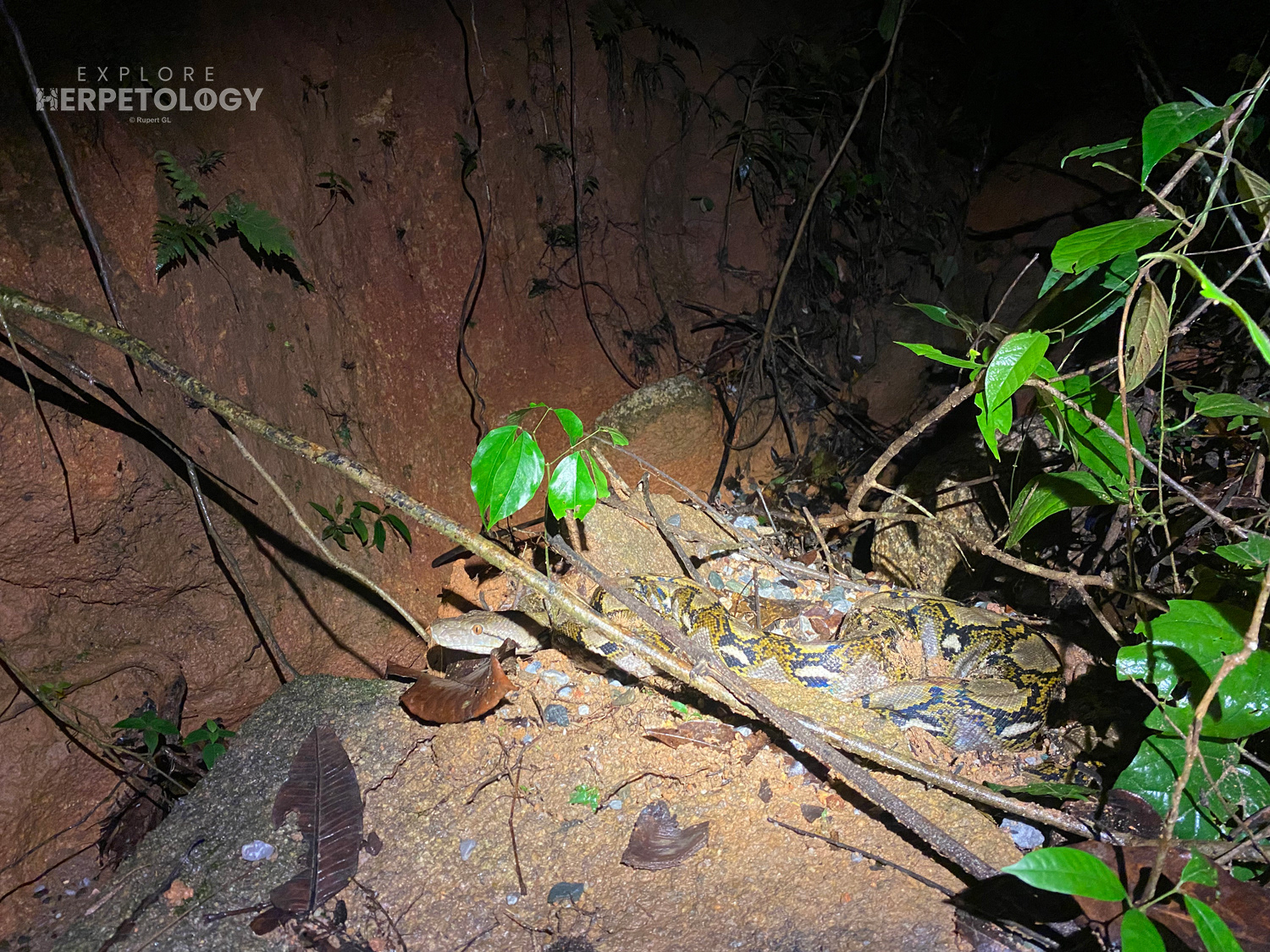
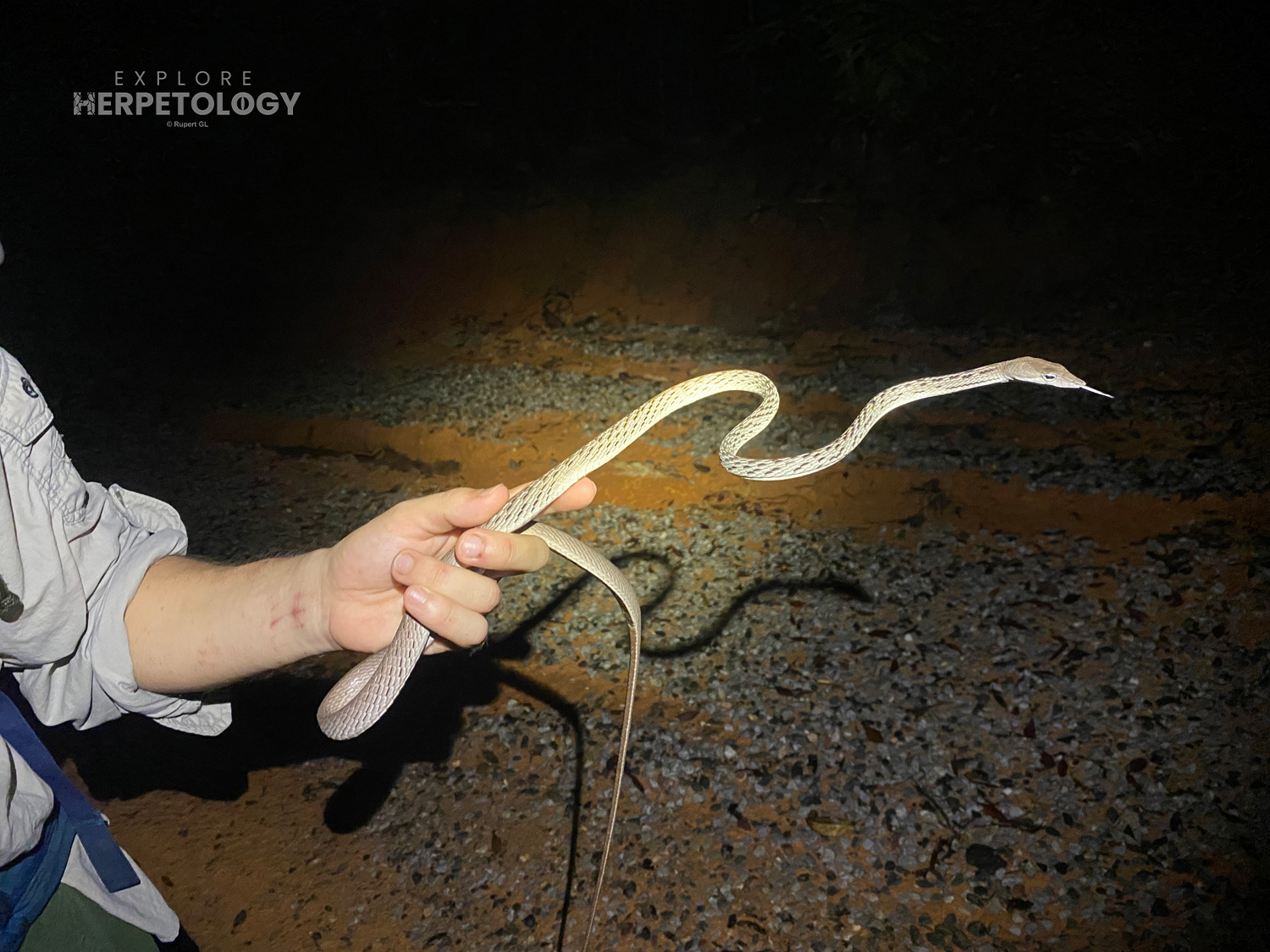
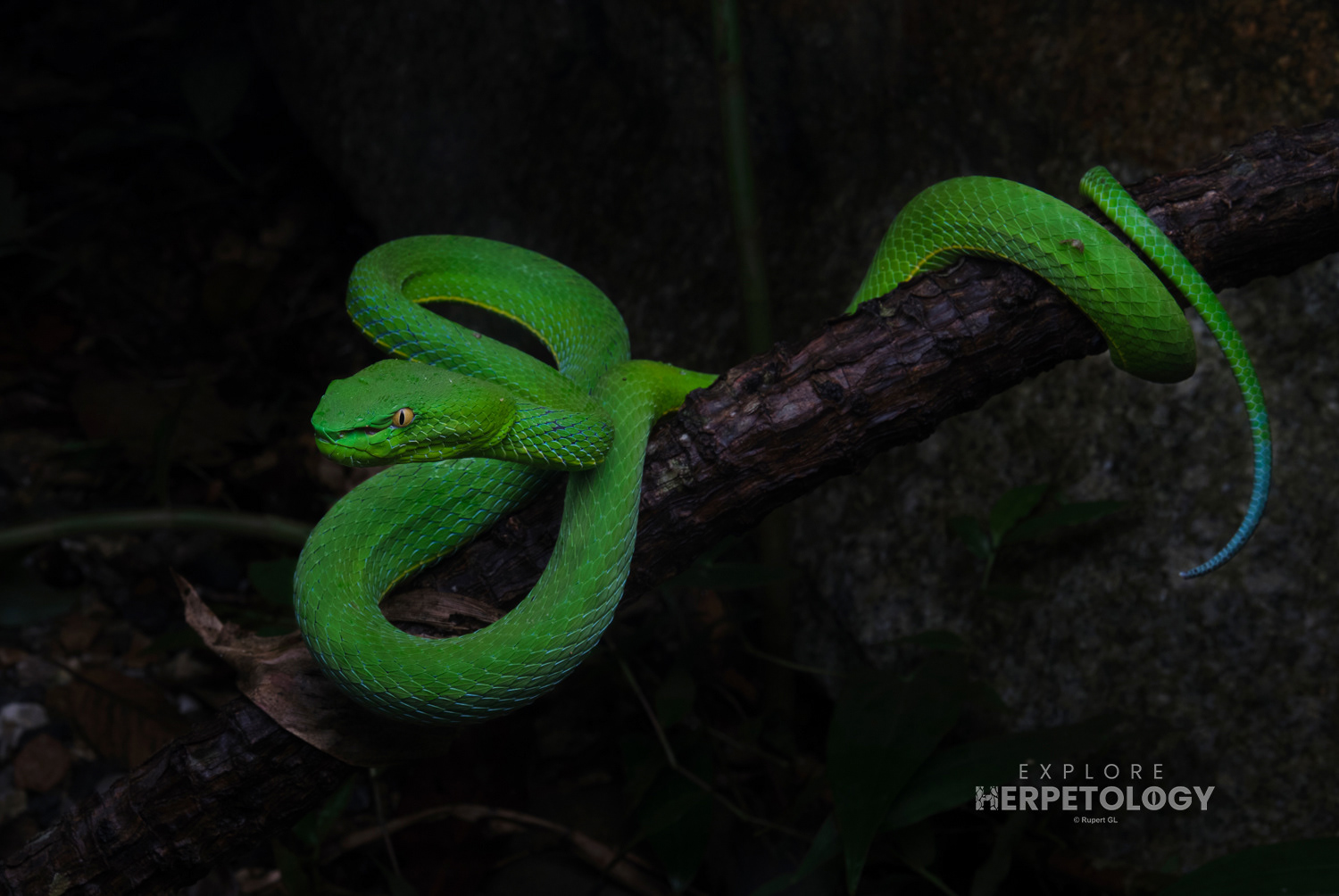
Unfortunately, once we reached the upper elevations it was cold, windy, and extremely foggy – we didn’t find a single snake. However, we did find some cool lizards, including Flower’s mountain agamid (Pseudocalotes floweri), a yellow-bellied dwarf geck (Hemiphyllodactylus flaviventris), a black-spotted litter skink (Scincella melanostica) and some giant Cardamom horned dragons (Acanthosaura cardamomensis).
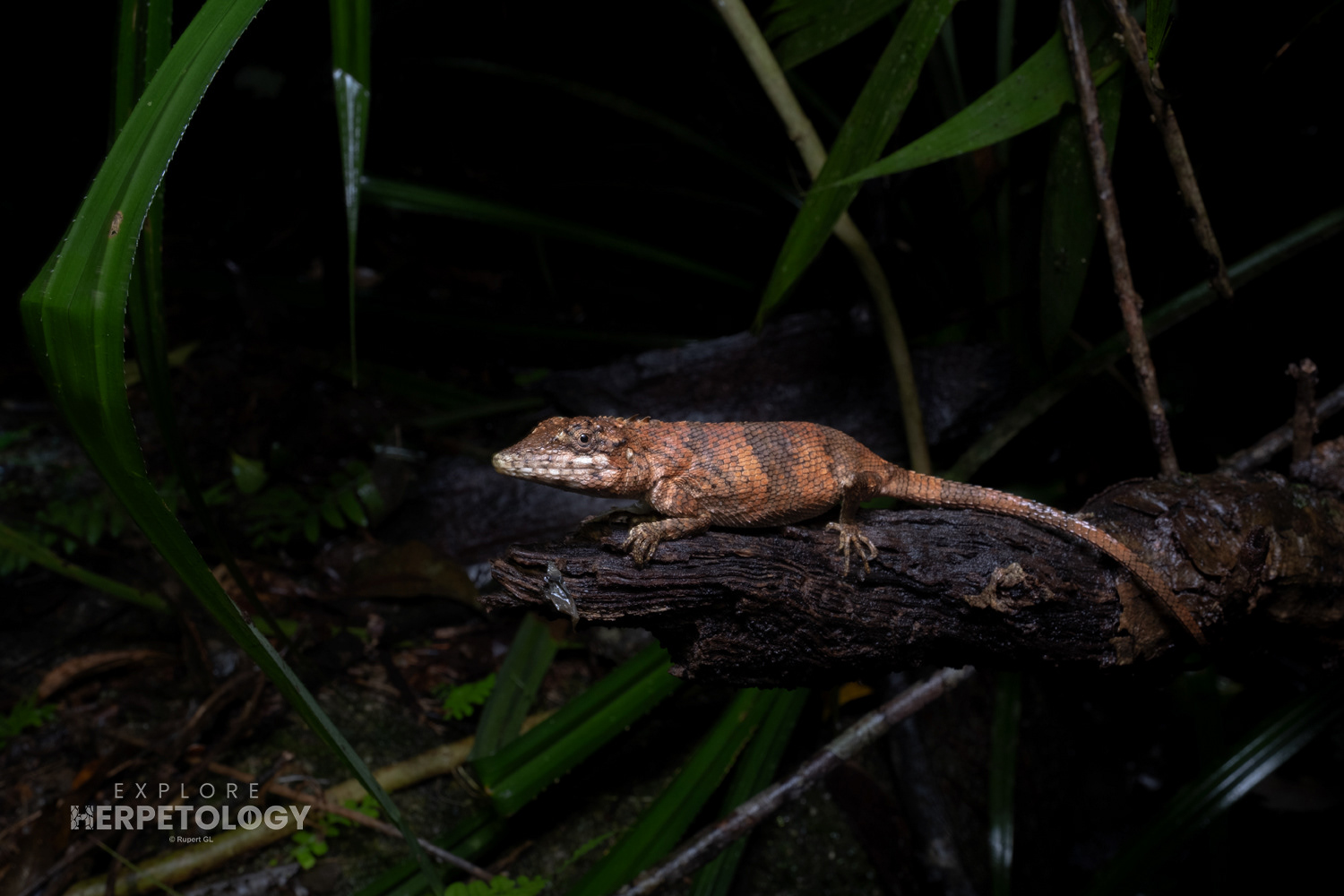
Flower’s mountain agamid (Pseudocalotes floweri).
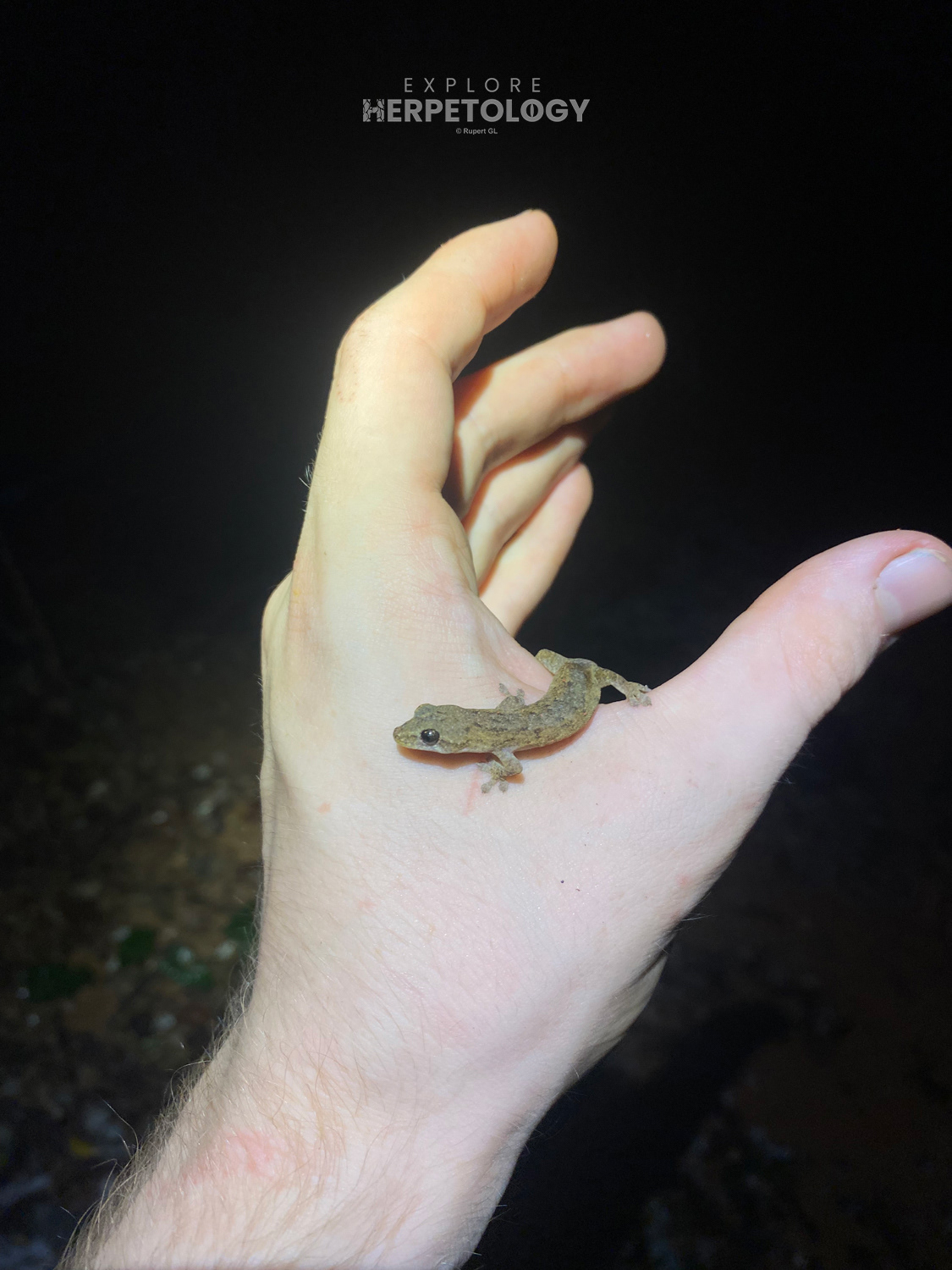
yellow-bellied dwarf geck (Hemiphyllodactylus flaviventris).

black-spotted litter skink (Scincella melanostica).

Cardamom horned dragons (Acanthosaura cardamomensis).
On the hike back down from 900m to (almost) sea level, we encountered another green cat snake (Boiga cyanea) and a male Vogel’s pit-viper (Trimeresurus vogeli) around 20 meters up a tree.
With two days remaining of the trip, we headed north from Chanthaburi into Nakhon Ratchasima province, located on the south-western fringe of the Isaan plateau. This was Harry’s old stomping ground and he assured us that if we searched the dry dipterocarp grasslands for long enough, we’d have a great chance to see our target species.

Sky, tree, tree, tree, grass.
We hit the forest early evening and turned up several species, including the Siamese cat snake (Boiga siamensis), possibly the best bycatch I could have hoped for; this ‘lifer’ species had been my white whale for so long, and finally meant I’d seen every Boiga in Thailand. Of course, after all this time of no observations, we found 3 massive individuals in 1 night.
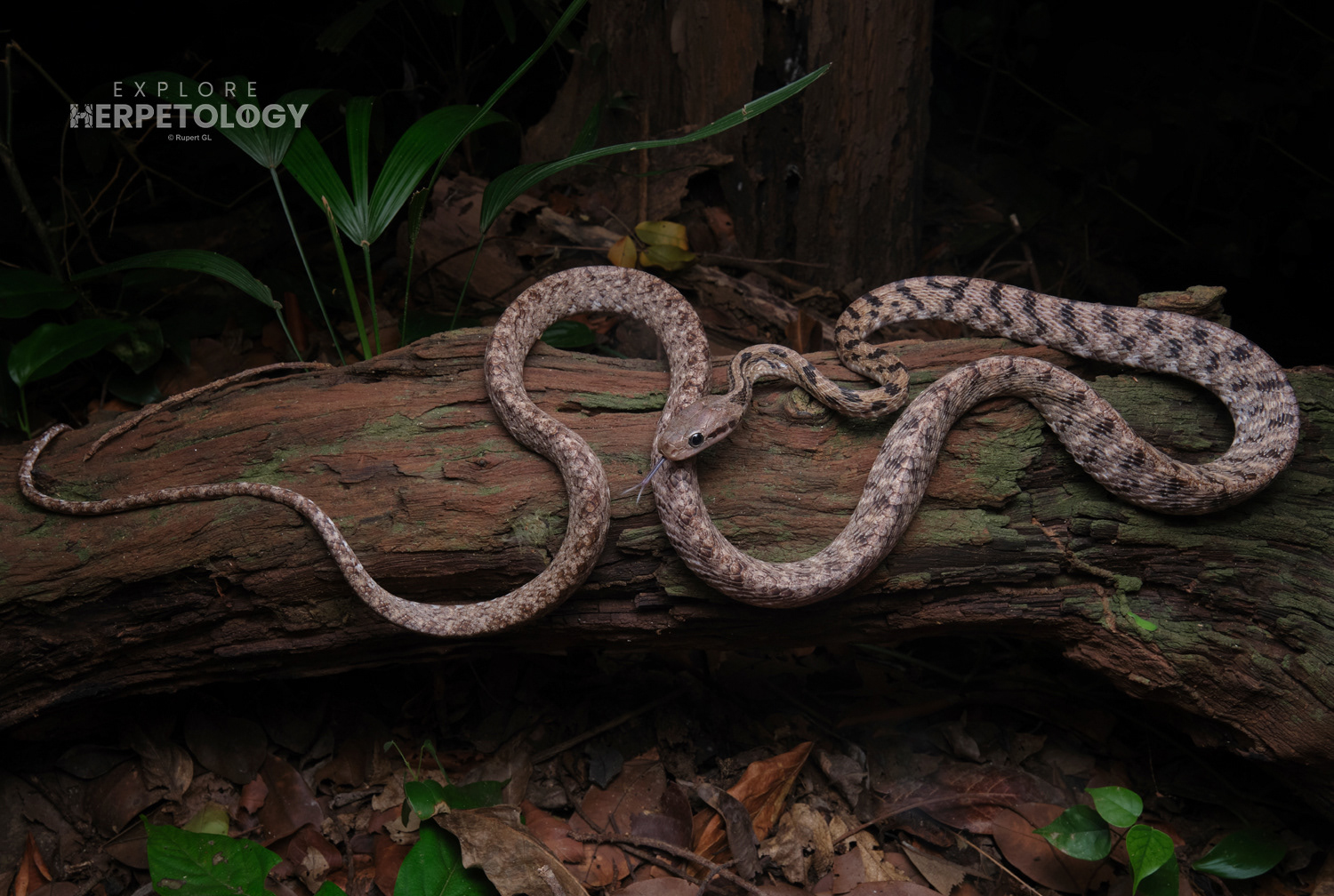
Boiga siamensis
Other road-cruised bycatch included one bright orange and one pale-morph small-banded kukri snakes (Oligodon fasciolatus), 2 Isaan-morph many-spotted cat snakes (Boiga multomaculata), and 2 juvenile large-eyed pit-vipers (Trimeresurus macrops).
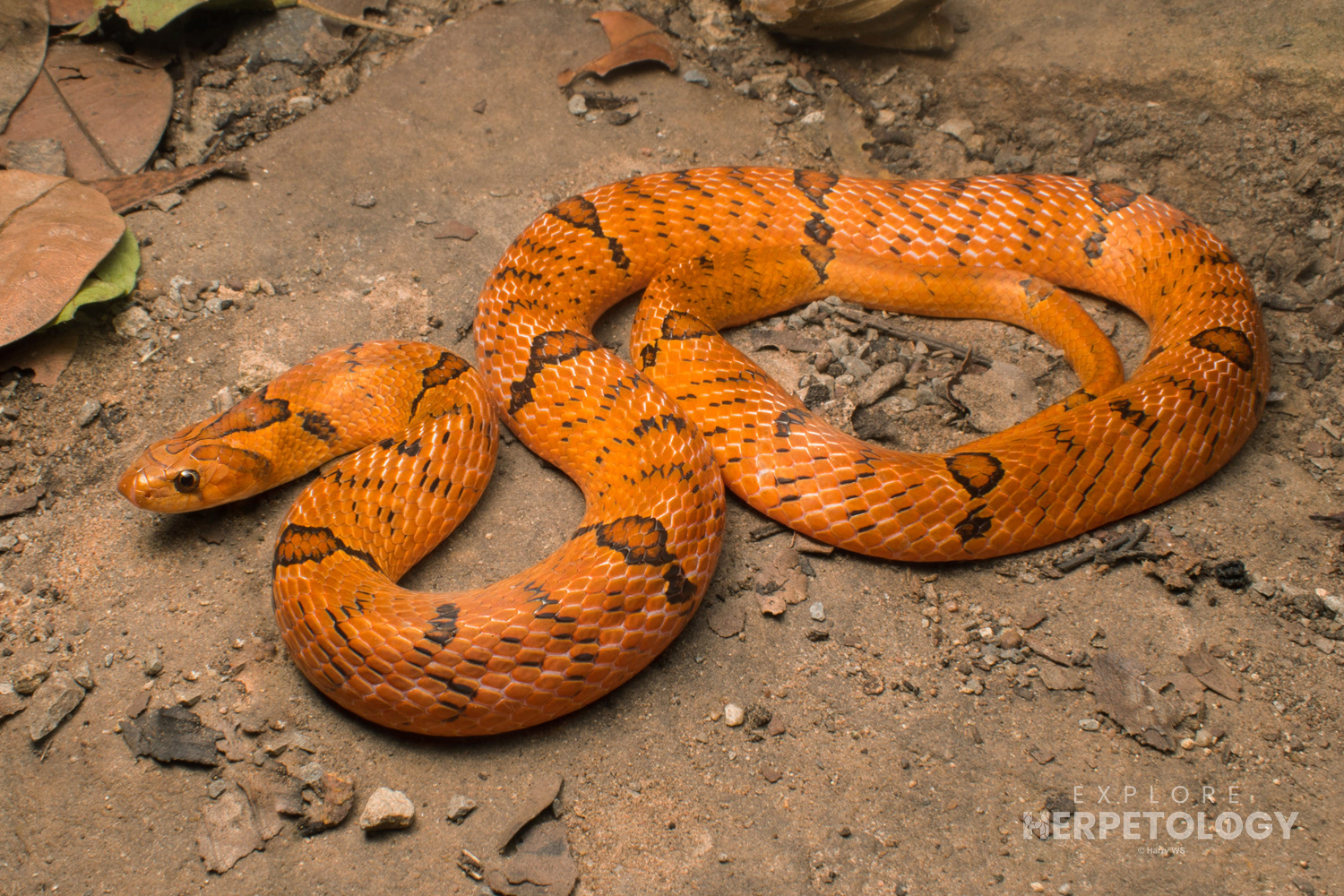
Red morph small-banded kukri snake (Oligodon fasciolatus).

Oligodon fasciolatus.

small-banded kukri snake (Oligodon fasciolatus).
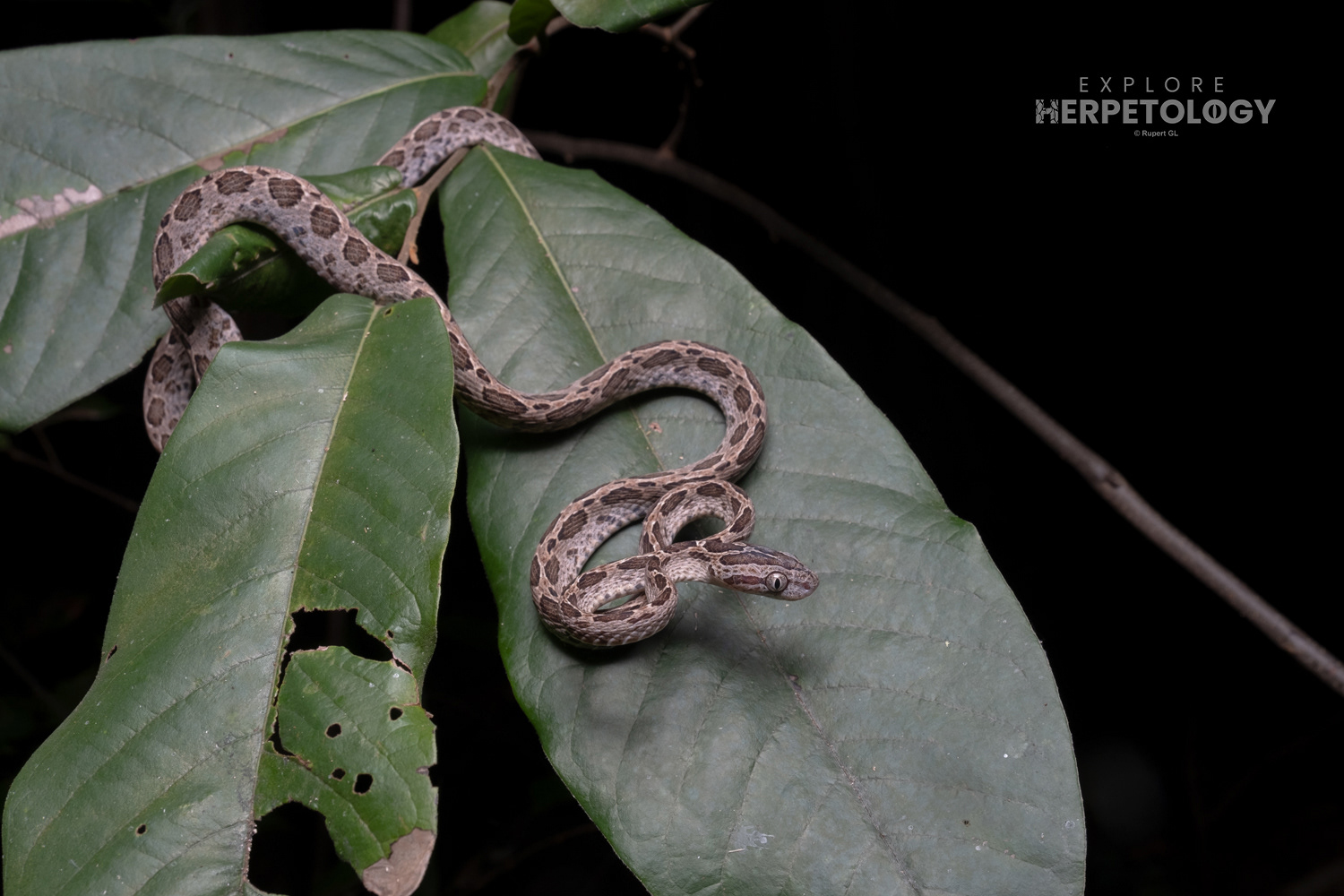
Boiga multomaculata.
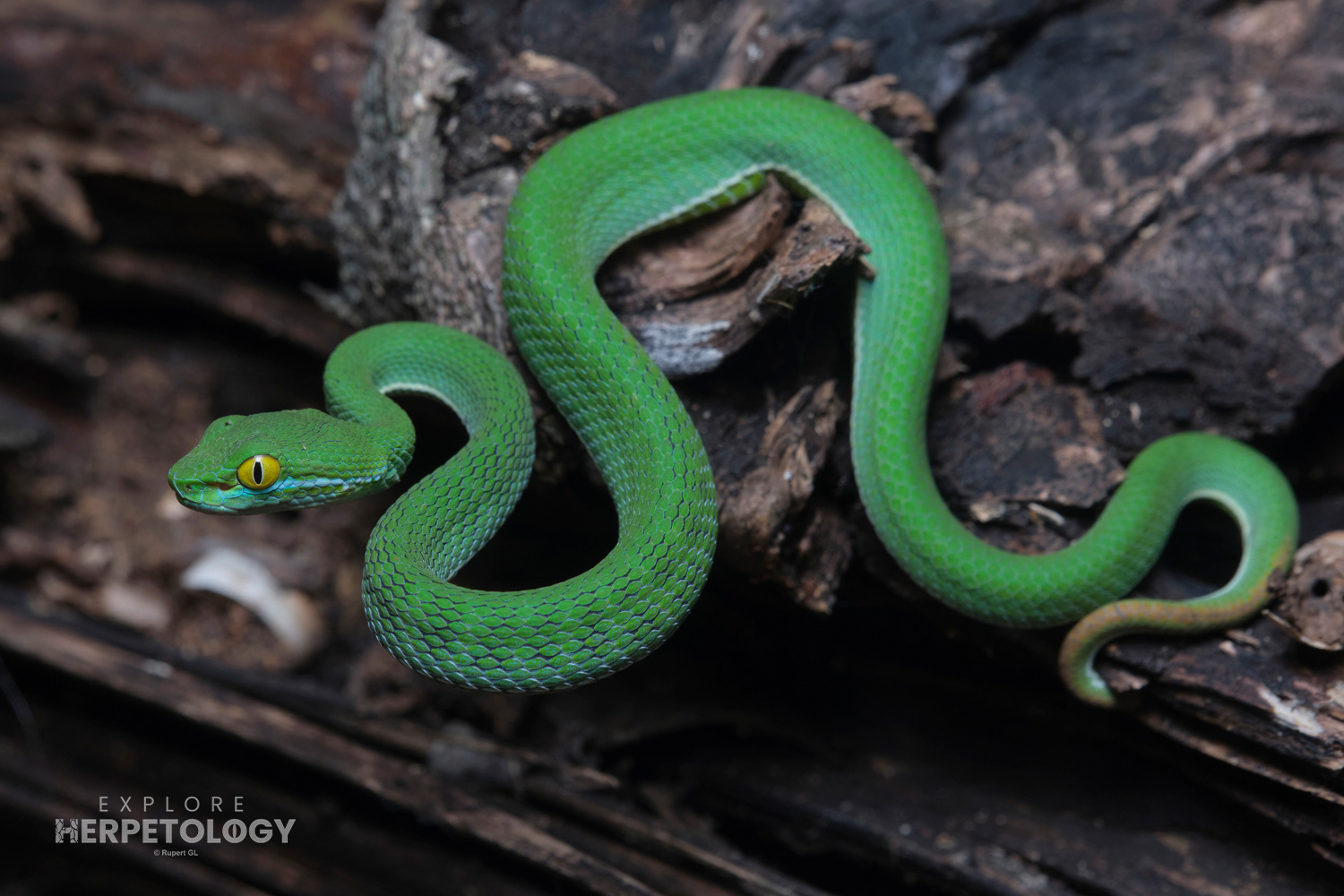
Trimeresurus macrops juvenile.
Our target was the false-striped kukri snake (Oligodon pseudotaeniatus), a little-known endemic to a small area in Eastern Thailand. Kukri snakes are usually most active in the early evening, so once it passed 11pm we were sceptical of our chances to see our primary target species. Regardless, we stuck to the strategy and at around 11.30pm, one shot out onto the road in front of us.

Oligodon pseudotaeniatus.
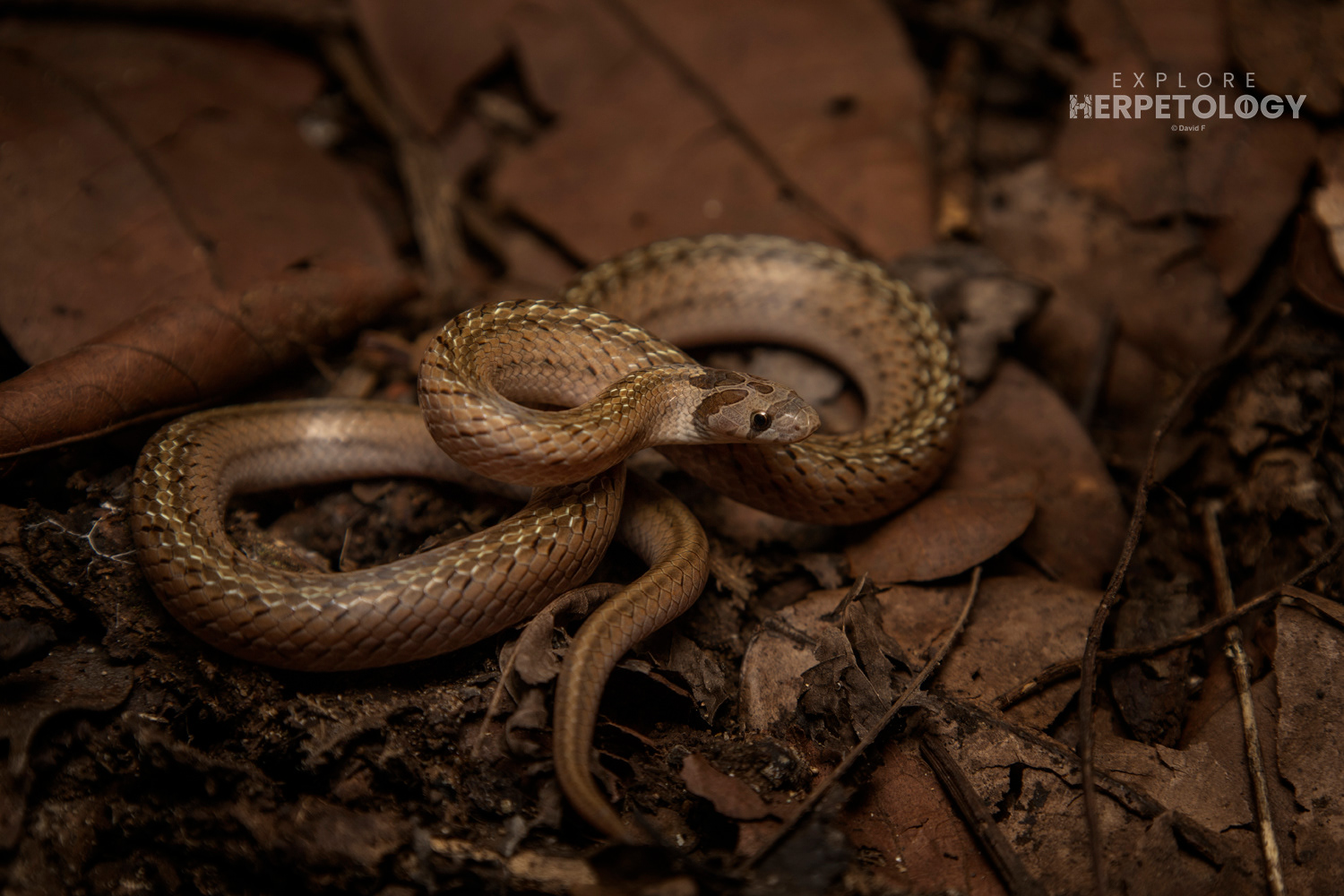
Oligodon pseudotaeniatus.
After finding our number 1 goal for the area, we went for a brief walk and turned up a couple more large-eyed pit-vipers (Trimeresurus macrops), 2 common wolf snakes (Lycodon capucinus) and a Davison’s bridle snake (Lycodon davisonii). We also found an angular bent-toed gecko (Cyrtodactylus angularis) and several stellar warty frogs (Theloderma stellatum) – the best amphibian find of the trip.

Davison’s bridle snake (Lycodon davisonii).
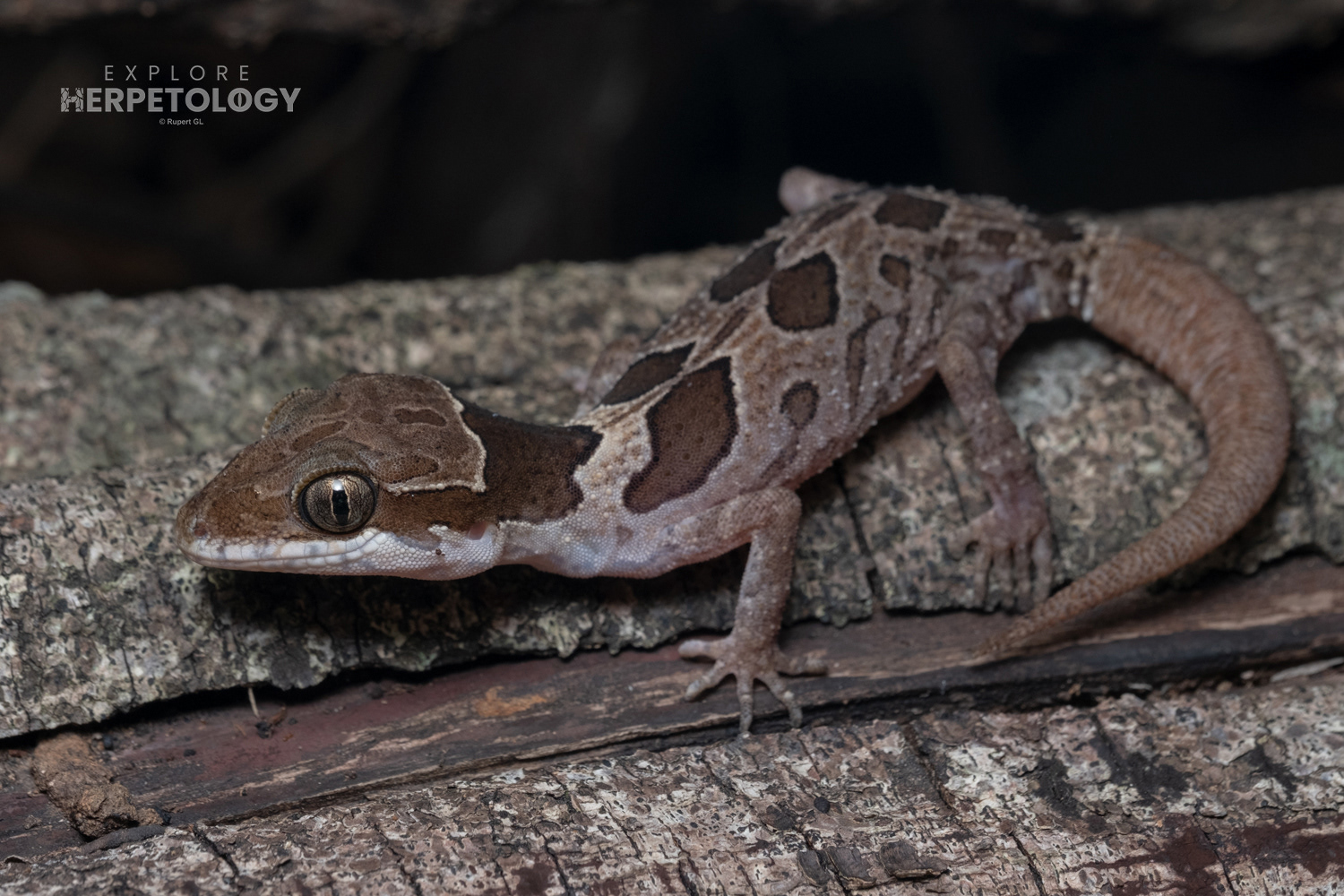
Angular bent-toed gecko (Cyrtodactylus angularis).
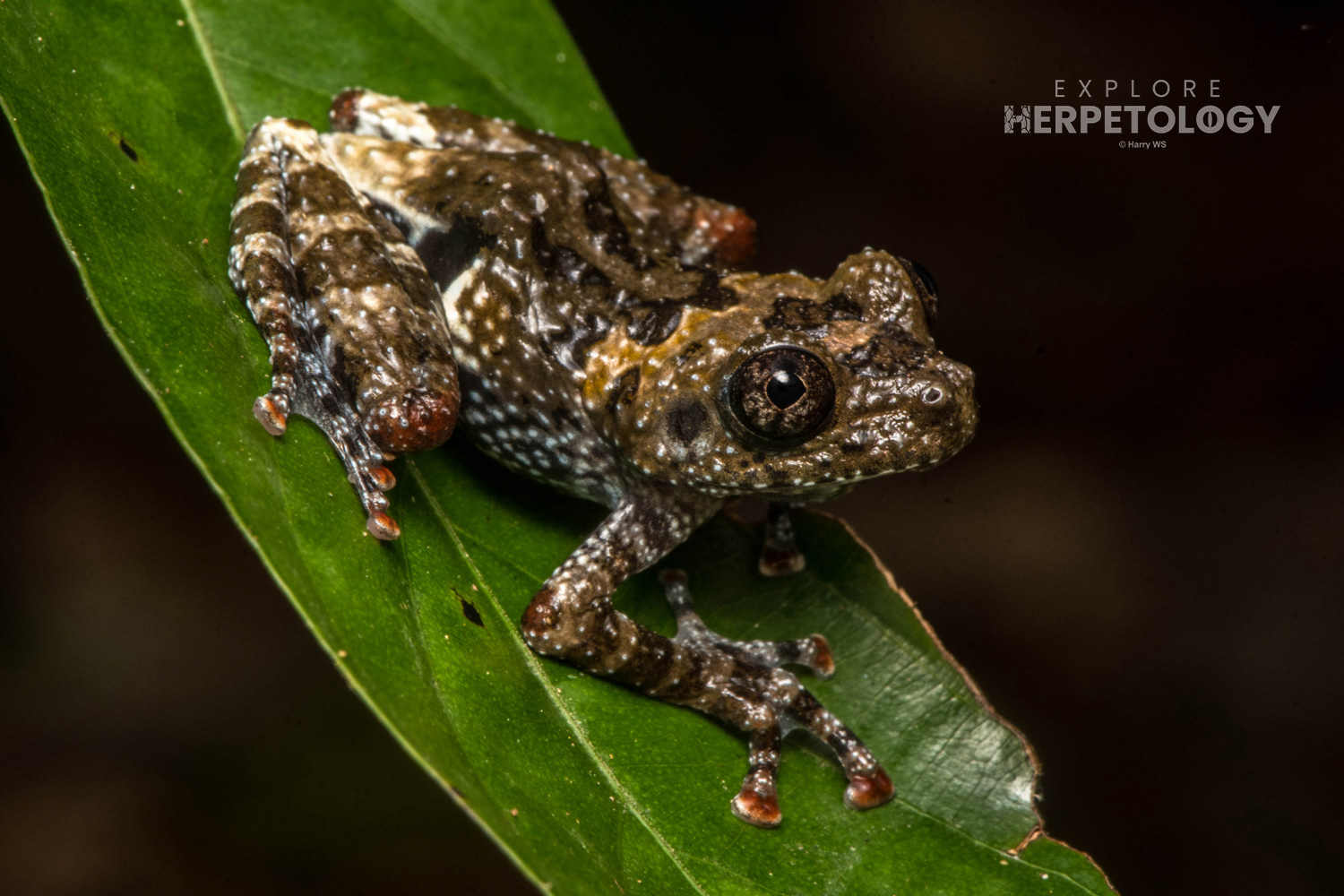
Stellar warty frogs (Theloderma stellatum).
With one more day/night left of the trip and with the vast majority of our forest-dwelling targets ticked off, we decided to head back into the agricultural lowlands to attempt one final time for Enhydris chanardi. This time, we tried two different known localities for the species in Nakhon Nayok and Prachin Buri provinces.
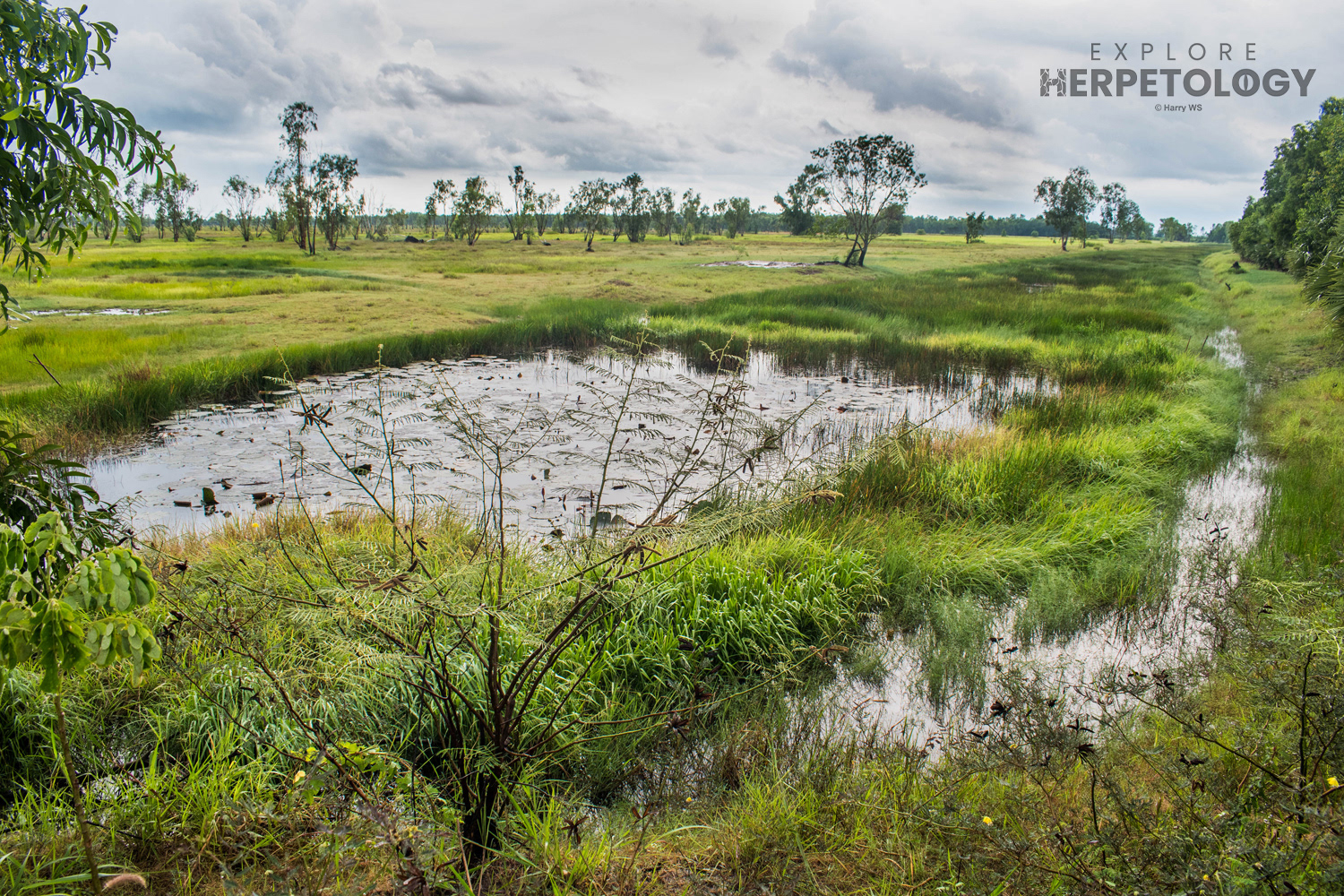
Seconds into the evening’s search, Harry went swimming for what we thought was Enhydris chanardi, but it turned out to be Enhydris enhydris – a truly cursed species at this point. Luckily, we also found a beautiful juvenile Burmese python (Python bivittatus) at the same time, lessening the pain.
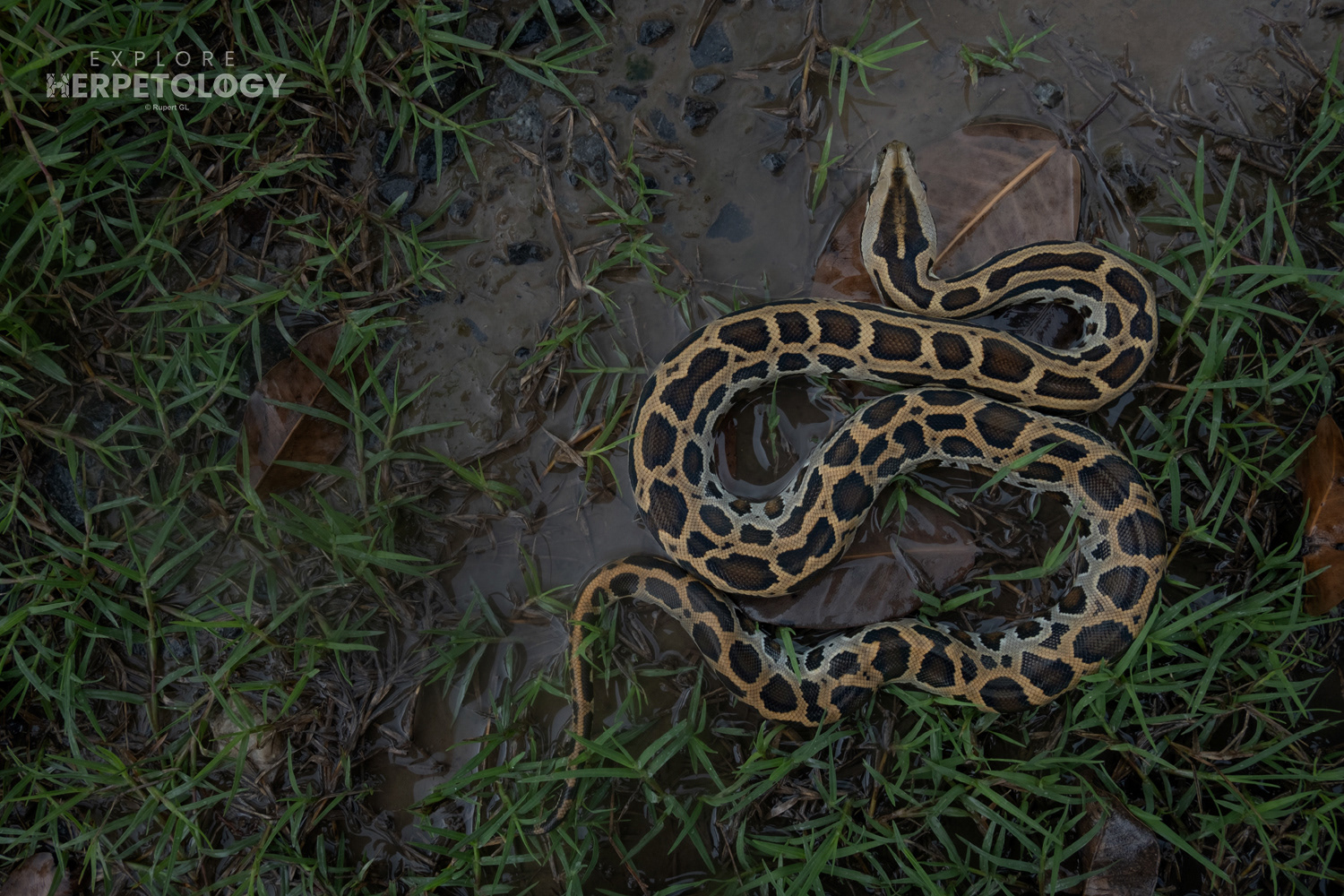
Burmese python juvenile.
After a while of hunting without anything besides Enhydris enhydris, we decided to up sticks and drive to the other known location for E. chanardi in Prachin Buri. While parked and trying to bring up the google maps route to the next location, we spotted a huge snake making its way out onto the road in the rain.
It turned out to be an absolutely huge monocled cobra (Naja kaouthia) with the faint banding often present on individuals from this part of Thailand. Despite being abundant throughout Thailand, anyone who has herped here knows these are incredibly difficult to find. This was a truly sensational moment, and we waited until the next day to take proper photographs.
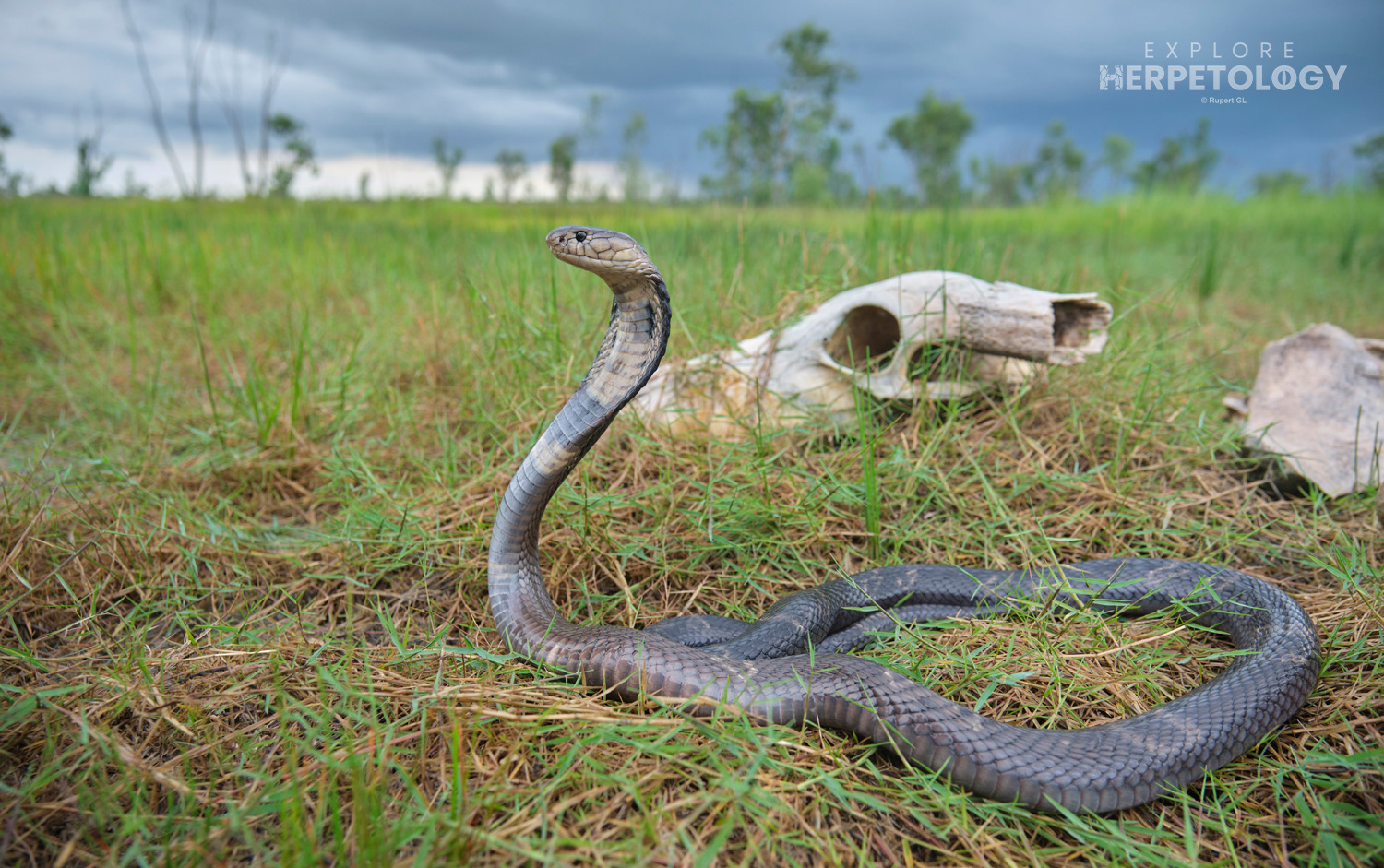
Monocled cobra (Naja kaouthia).
Charged up off this awesome encounter, we hit the next location with a vengeance. We scouted potential sites from the car until we found a sequence of small ponds which looked promising, then split up to cover as much ground as possible. Sure enough, it took hardly any time at all before we found and caught an adult Chan-ard’s mud snake (Enhydris chanardi) – an inevitable conclusion to an unthinkably successful trip.
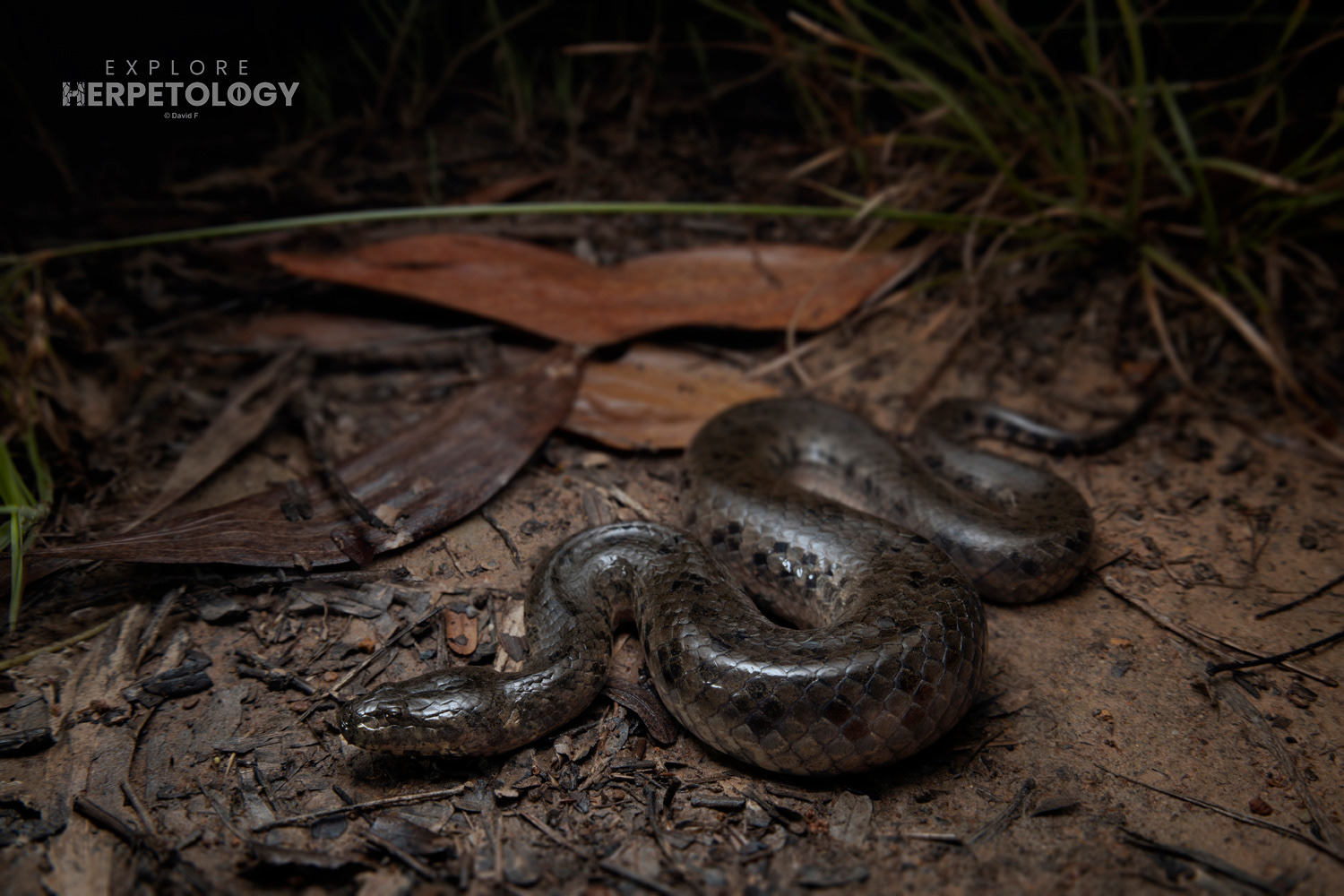
Chan-ard’s mud snake (Enhydris chanardi).
It feels like every time an expedition ends, we’re saying “this was the best trip ever!”, but this was certainly a serious contender. Beautiful new habitat, several lifer species for each of us, and unbelievable encounters such as the Siamese Russell’s viper (Daboia siamensis) and monocled cobra (Naja kaouthia). This trip will not be forgotten in a hurry.
Explore Herpetology are heading back to Narathiwat on a public expedition with guests in early August, so that will be our next trip report. However, following that will be a sequence of extremely exciting private expeditions to northern Thailand, so stay tuned.
Complete Species List of the trip:
*Note: Species may appear in this list but not the above report if individuals were not photographed or observations were fleeting.
Snakes:
Ahaetulla fusca
Ahaetulla prasina
Boiga cyanea
Boiga multomaculata
Boiga siamensis
Bungarus candidus
Daboia siamensis
Dendrelaphis ngansonensis
Enhydris chanardi
Enhydris enhydris
Fowlea flavipunctatus
Hebius boulengeri
Hypsiscopus plumbea
Lycodon capucinus
Lycodon cardamomensis
Lycodon davisonii
Malayopython reticulatus
Naja kaouthia
Oligodon fasciolatus
Oligodon pseudotaeniatus
Oligodon taeniatus
Psammodynastes pulverulentus
Ptyas korros
Python bivittatus
Rhabdophis siamensis
Subsessor bocourti
Trimeresurus albolabris
Trimeresurus cardamomensis
Trimeresurus macrops
Trimeresurus vogeli
Xenopeltis unicolor
Lizards:
Acanthosaura cardamomensis
Bronchocela burmana
Calotes emma
Calotes versicolor
Cnemaspis chanthaburiensis
Cyrtodactylus angularis
Cyrtodactylus intermedius
Draco taeniopterus
Eutropis macularia
Eutropis multifasciata
Gehyra mutilata
Hemiphyllodactylus flaviventris
Lygosoma corpulentum
Physignathus cocincinus
Pseudocalotes floweri
Scincella melanosticta
Takydromus sexlineatus
Varanus salvator
Amphibians:
Duttaphrynus melanostictus
Fejervarya limnocharis
Hylarana erythraea
Ichthyophis kohtaoensis
Kaloula pulchra
Limnonectes gyldenstolpei
Megophrys lekaguli
Microhyla heymonsi
Polypedates megacephalus
Quasipaa fasciculispina
Sylvirana nigrovittata
Theloderma stellatum



